Some three thousand years ago the nation of Israel was threatened with destruction. On one side of a steep valley was assembled the Israelite army, led by King Saul. Camped on the opposite side of the valley were the armies of the Philistines, ready for battle.
 The Philistines challenged Saul to decide the outcome of the battle in single combat. The Philistine champion was a fearsome warrior by the name of Goliath. Goliath was a giant of a man. He inspired such dread amongst the Israelites that no man could be found who was willing to confront him. The Philistines challenged Saul to decide the outcome of the battle in single combat. The Philistine champion was a fearsome warrior by the name of Goliath. Goliath was a giant of a man. He inspired such dread amongst the Israelites that no man could be found who was willing to confront him.
Finally, after forty days, a young shepherd stepped forward and announced that he was ready to face Goliath. The name of this youth was David. He was the youngest of eight sons born to Jesse of Bethlehem.
According to the Book of Samuel in the Old Testament of the Bible, David felled Goliath with a single stone from his sling, causing the Philistines to flee in terror and allowing the Israelites to win a great victory. For his valor, David became an acclaimed leader, and went on to succeed Saul as the King of Israel.
Now, in the early years of the 21st century, the people of Israel stand once again confronted by enemies who have sworn to destroy them. At a time of perceived weakness, Israel is once again in need of a new champion – one who can withstand the menace of these opposing forces and defend the Jewish nation in its hour of need.
Such a man has arrived on the world stage, ready to claim the mantle of saviour. He is not a man new to power, but one strengthened by past battles, and now ready to take his appointed place in history as the new David. This man is known to friends and enemies alike as “Bibi” – Benyamin Netanyahu.
 “Bibi” is unique among those who have been called upon to lead the nation of Israel, as he is the first and only person to become Prime Minister who was born after the foundation of Israel on May 14, 1948. “Bibi” is unique among those who have been called upon to lead the nation of Israel, as he is the first and only person to become Prime Minister who was born after the foundation of Israel on May 14, 1948.
He spent five years serving his country as a distinguished captain of an elite commando unit at the time of the Six Day War. His elder brother Jonatan (“Yoni”) became a hero when he was killed in 1976 while leading the successful raid on Entebbe to rescue passengers and crew aboard a hijacked Air France Airbus.
When “Bibi” was a teenager, his family moved to the United States, where he was educated at Cheltenham High School in Philadelphia. He later earned a B.S. degree in Architecture in 1975, and then went on to study Political Science at Harvard and MIT.
As a result of his experience in the United States, he became an articulate defender of Israeli interests in the West, and was a frequent guest on radio and television. It was during these interviews that he began to advocate the need to counter the growing threat to Israel posed by Iran.
He likened Iran to Germany during the time of Hitler, and especially warned against the fact that Jews failed to take Hitler’s threats seriously, even though he had clearly outined in his book “Mein Kampf“, exactly how he planned to liquidate the Jews.
In an interview with CNN in 2007, Netanyahu claimed that the main difference between Nazi Germany and the Islamic Republic of Iran was that, whereas Hitler had begun a worldwide conflict before seeking atomic weapons, Iran was seeking nuclear weapons first, and then planned to embark on a campaign of global conquest.
This is a theme that Netanyahu returns to again and again. In a recent interview on Israeli TV, he called Iran the greatest danger to Israel and to all humanity. He said that if he was elected Prime Minister, his first objective would be to deal with the growing Iranian nuclear threat.
When asked if that might include a military strike on the Iranian nuclear facilities at Natantz, Netanyahu responded: “It includes everything that is necessary to make this statement come true.”
An Iranian Goliath now awaits the challenge of the new David. All that remains is to see what weapon he will choose for his response.
Allan, Signs of the Times, April 1, 2009, 6:47 pm
As the world reels under the weight of the worst economic crisis since the Great Depression, another drama is unfolding in the Middle-East that has long been predicted. It threatens to light the powder keg that has been growing steadily more explosive over the last decade.
This drama began in 1979 with the overthrow of the Shah of Iran and the return of the Ayatollah Ruhollah Khomeini, and his subsequent elevation to the position of Supreme Leader of the Islamic Republic of Iran.
While Khomeini was quick to brand America as “the Great Satan”, he was also an implacable foe of what he called the threat of Zionism. As he proclaimed at the time, “No matter what words you use to describe it, it’s the same enemy.”
Khomeini went on to announce that Israel should be “wiped off the face of the earth”. It was his revoutionary zeal to crush the world of Zionism that has become the crusading fervour behind the words and policies of his devout follower Mahmoud Ahmedinejad, the current President of Iran.
According to Ahmadinejad, the Ayatollah Komeini was committed to a policy of revolutionary force in overcoming the enemies of Islam. And this force justified the use of sophisticated weaponry, including nuclear technology.
Since the death of Khomeini in 1989, Iran has steadfastly pursued the goal of becoming a nuclear power. In the face of increasing opposition in the West, Iran turned initially to Abdul Qadeer (A.Q.) Khan, widely considered today to be the founder of Pakistan’s nuclear program.
In 2005, Khan confessed that he had been involved in a clandestine network of nuclear weapons technology, and that by means of this network had supplied gas centrifuges to North Korea. It was the North Korean Government that then passed on this technology to Tehran.
Over the last three years, Iran has assiduously worked to increase its number of gas centrifuges, as well as its stock of fissionable material. While it continues to claim that its objective is to use this material solely for peaceful purposes, the latest reports indicate that Iran now has enough weapons grade material to build a nuclear device.
The Atomic Energy Agency recently admitted that it had underestimated Iran’s nuclear stockpile by about one third. It went on to confirm that the country now possesses 2,227 lbs of enriched Uranium 235, sufficient to create at least one nuclear bomb.
At the same time that Iran has been pursuing its nuclear ambitions, it has also been developing its long-range missile program. On February 2 of this year, Iran successfully launched a satellite into outer space, ostensibly designed to “monitor earthquakes”.
Few overseas observers believe that the timing of this launch was coincidental, or that its purpose was simply to monitor the land. It seems clear that Iran is rapidly approaching its goal of attaining nuclear weapons, as well as the capacity to deliver those weapons anywhere within the Middle-East.
There is one final ingredient which has now been added to this explosive mix. This involves the S-300 advanced air defence system developed by Russia. This state of the art defence system can track scores of incoming planes simultaneously, and can shoot them down irrespective of whether they are high-altitude bombers or low-altitude drones.
Although Russia has agreed to supply Iran with this sophisticated air defence system, it has temporarily suspended delivery, pending discussions with the United States. The outcome to these discussions will determine just how soon Iran will be able to acquire these S-300 missiles.
Allan, Signs of the Times, March 4, 2009, 9:36 am
According to the Oracle of Tolemac, a specific series of events will occur in the Middle East that will lead up to the appearance of the Anti-Christ and the ultimate return of the Redeemer. These events will involve the people of Israel and the armies of its enemies. It is to the Middle East that we need to look for the true signs of the times.
When asked who the Redeemer of the world would be, the Oracle replied:
“The Son of man is the Great Redeemer spoken of in the holy books. He is the one who will come to save the faithful at the appointed end of the age. When the Son of man returns to the earth with power and great glory, he will be recognized by all peoples as “the one who is to come”.
“Every religion has its own tradition of a savior who will return to earth at the end times. To those of the Christian faith, the Son of man will be Jesus, the living Christ. To the Jews, he will be the long awaited Messiah. To the Hindus he will be Kalki, the tenth incarnation of Vishnu. To the Buddhists he will be the Maitreya, the Buddha that is to come. To the Moslems he will be the Mahdi, the expected one.”
Materially minded men and women may scoff at the idea of a religious savior returning to the earth in a few years to castigate the wicked and spare the faithful, but this idea happens to be the motivating force behind one of the most powerful personalities in the Middle-East today.
 For this idea of the return of a Moslem Redeemer known as the “Mahdi” is the central belief of the man who is now President of Iran, Mahmoud Ahmadinejad. For this idea of the return of a Moslem Redeemer known as the “Mahdi” is the central belief of the man who is now President of Iran, Mahmoud Ahmadinejad.
While all streams of Islam believe in a divine savior known as the “Mahdi”, many Shi’a Moslems believe that this “Expected One” will be a direct descendant of the Prophet Muhammad, known as the 12th Imam.
This belief is particularly prominent in Iran, where adherents are known as “Twelvers”. According to their teachings, the 12th Imam will return to the earth after a time of cosmic chaos, bloodshed and war, and will lead the world into a new era of universal peace.
From the moment he was elected President, Ahmadinijad has been obsessed with the need to prepare Iran for the coming of the 12th Imam. At a cabinet meeting convened in July 2005, he told the assembled ministers: “We have to turn Iran into a modern and divine country to be the model for all nations, and which will serve as the basis for the return of the 12th Imam.”
Since that time, Ahmadinejad has made frequent references to this Islamic Redeemer, including his recent Christmas address to the people of Great Britain that was broadcast on Channel 4 TV.
However, this call to prepare Iran for the return of the redeemer carries a sinister undertone. In fulfilling his destiny as President, Ahmadinejad believes he has been given a divine mandate to rid the world of unbelievers and so prepare the world for the savior who is coming.
And no one has been the focus of this crusade more than the people of Israel. Shortly after being elected President, Ahmadinejad spoke at a conference in Tehran entitled “The World Without Zionism”. At this conference he outraged the West when he announced that Israel was a “disgraceful blot that should be wiped off the face of the earth.”
In defending his words, the President claimed that he was merely echoing the words of the founder of the Iranian revolution, Ayatollah Khomeini. “As the Imam said, Israel must be wiped off the map.”
These widely quoted words might be dismissed as the rantings of a misguided man were it not for one salient fact. That man just happens to be President of a nation committed to the pursuit of nulear power.
And it is not lost on the West, and least of all in Israel, that these words of President Ahmadinejad are a warning that – when the time is right – action will follow words.
Allan, Signs of the Times, March 3, 2009, 2:47 pm
According to the Oracle of Tolemac, a specific series of events will occur in the Middle East that will lead up to the appearance of the Anti-Christ and the ultimate return of the Redeemer. These events will involve the people of Israel and the armies of its enemies.
It is to the Middle East that we need to look for the true signs of the times. The Oracle warned that talks of peace in the Middle East would soon give way to thoughts of war. And the events that have taken place in Gaza over the last month have proved this warning to be correct.
But the onset of hostilities between the armed forces of Israel and the supporters of Hamas have little to do with the reasons advanced in the public press. Instead, perceptive students of Middle Eastern affairs will recognize that the entire Gaza campaign has been a high stakes gamble by the ruling political party in Israel to maintain its hold on power.
Ever since the abortive Lebanese campaign, the ruling Kadima party under the leadership of Ehud Olmert, has faced increasing opposition and unpopularity, culminating in the move to strip Olmert of his position as Prime Minister on the grounds of corruption.
Because his chosen successor, the Foreign Minister Tzipi Livni, was unable to form a majority coalition, the President of Israel Shimon Peres was obliged to call for a new general election to be held on February 10, 2009. It was against this backdrop of impending elections that the Gaza campaign was conceived and carried out.
By choosing to attack their avowed foes in Gaza, the Kadima party clearly hoped that they would be able to win back the faith of the majority of the electorate, and maintain their hold on power.
As the events in Gaza unfolded however, it became clear that this high-risk gamble had failed. Not only did the three week campaign fail to subdue Hamas, it also failed in its primary intent, which was to stop the rockets which were being fired from Gaza into Southern Israel.
This failure looks likely to lead to a change in Government, with the reigns of power returning once again to the leader of the Likud party, Binyamin Netanyahu.
If this does prove to be the case, there is every likelihood that the final piece of the ancient Biblical prophecies of the events leading up to the appearance of the Anti-Christ will at last be in place.
Allan, Signs of the Times, February 3, 2009, 5:25 pm
Previous entries have dealt with the question of the existence of an ancient culture in the Amazon Basin that was known as Paititi. Based on the information presented there, there is credible evidence that an advanced culture once lived in this area, and that it exhibited a high degree of technical expertise.
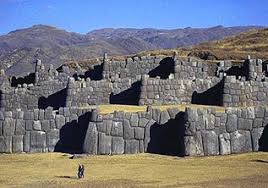 In particular, the ability to construct megalithic structures such as the fortress of Sacsayhuaman outside Cuzco with stones weighing up to 200 tons, rivals anything that has been constructed since. In addition, a network of underground tunnels has been found throughout South America that could not have been built by any of the cultures known to have existed in the region. In particular, the ability to construct megalithic structures such as the fortress of Sacsayhuaman outside Cuzco with stones weighing up to 200 tons, rivals anything that has been constructed since. In addition, a network of underground tunnels has been found throughout South America that could not have been built by any of the cultures known to have existed in the region.
The discovery of metallic plates imprinted with a script that has yet to be deciphered, indicates a culture more sophisticated than the Incan Empire, which did not know about the wheel and had no written form of literature.
The question raised by some readers is that, if an advanced technological civilization had once lived in South America, would there not be some evidence demonstrating their technical expertise that would still exist today. The answer to this question naturally depends on how long ago this society lived, and what happened to it to cause its downfall.
If their downfall was the result of a series of natural disasters leaving few survivors, then very little might remain beyond legendary stories handed down from generation to generation, and a few artifacts scattered here and there. Those who survived might have had little choice but to live in caves and carve a record of their achievements on stones, hoping that these might survive to tell the tale of their former glory.
It so happens that a cache of stones with enigmatic carvings has been found in a tiny village located near the town of Ica in southern Peru. The fact that this collection of enigmatic stones can be seen today is the result of the indefatigable efforts of a local physician by the name of Javier Cabrera.
Allan, The Stones of Ica, January 31, 2009, 10:18 am
In 1966, knowing of his interest in the local Indian culture, Dr. Cabrera was given an unusual gift for his birthday. It was a small carved rock. The rock seemed to be ancient, but what interested Dr. Cabrera most was that it depicted the outline of a fish, but one that was not common to the area and might even be extinct.
When he asked where this stone was found, he was told that it was found under the ground near the village of Ocucaje. Realizing that these stones could prove to be of great historical importance, he asked if any more could be found. To his astonishment, the farmer began to bring him what seemed like a never ending supply.
Over the years Dr. Canbrera created a small museum at his home in Ica to contain all these stones. His museum ultimately came to contain over 11,000 stones. They ranged in size from tiny palm sized stones to others that were several feet in diameter. How many stones were originally carved has never been determined, for many thousands of other carved stones have been sold to tourists by the inhabitants of Ocucaje to generate income.
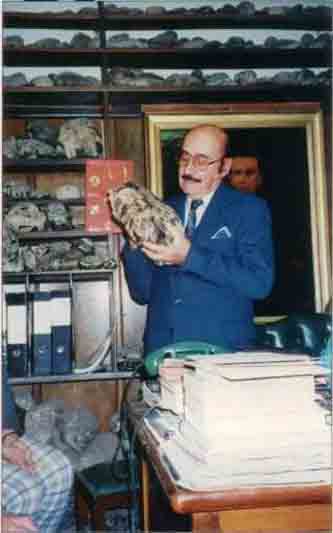 As time passed and word of his unusual collection grew, so more and more people traveled to Ica to visit Dr. Cabrera and see for themselves these extraordinary stones. They were stored in separate rooms, based on their size and on the subject matter they depicted. Dr. Cabrera was always glad to entertain visitors and show off his display. As time passed and word of his unusual collection grew, so more and more people traveled to Ica to visit Dr. Cabrera and see for themselves these extraordinary stones. They were stored in separate rooms, based on their size and on the subject matter they depicted. Dr. Cabrera was always glad to entertain visitors and show off his display.
All of these stones have images carved into them with continuous lines etched into the surface of the rock. The etched grooves are lighter in color than the rock, but they have a patina of natural oxidation and appear to have been carved in ancient times.
The stones themselves are made of “andesite”, a gray to black volcanic rock that is commonly found in the Andes Mountains. One particular feature of this rock is that, being as hard as granite, it is difficult to cut with ordinary tools. The advantage of using this type of rock is that, being resistant to abrasion, these carvings would last for many thousands of years, particularly in a region as dry as the coastal desert of Peru.
Allan, The Stones of Ica, January 30, 2009, 3:59 pm
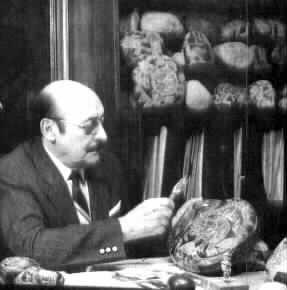 In the forty years that have elapsed since these stones first came to the attention of Dr. Cabrera, they have aroused fierce controversy. It would be fair to say that most archeologists and scientists trained within the accepted paradigm of history are convinced that these stones are fakes. They remain convinced that they were carved by local Indians as a means of generating income by selling them to gullible tourists as ancient artifacts. In the forty years that have elapsed since these stones first came to the attention of Dr. Cabrera, they have aroused fierce controversy. It would be fair to say that most archeologists and scientists trained within the accepted paradigm of history are convinced that these stones are fakes. They remain convinced that they were carved by local Indians as a means of generating income by selling them to gullible tourists as ancient artifacts.
Dr. Cabrera initially shared this view, particularly when the local farmer who had supplied him with the stones admitted that he had carved these pieces himself. When the Peruvian authorities became concerned that a thriving industry might develop in which genuine Peruvian antiquities might be lost, they arrested the man. Fearing that he might be imprisoned for theft under the Antiquities Act, he quickly confessed.
The fact that an illiterate peasant had confessed to having single-handedly carved some 15,000 stones without the knowledge of any of his fellow villagers, clearly did not trouble the Peruvian authorities. They merely accepted his word and released him. Yet had this man been responsible for carving the images himself, the task would have taken him over 40 years, assuming that he was able to complete one stone a day, every day without a break.
Dr. Cabrera never publicly divulged the true source of these stones, other than to say that they were discovered underground in a small area close to the village of Ocucaje. It was clear that other people besides Cabrera had discovered the source of the stones, as visitors to Ocucaje found that almost every villager had a collection of carved stones which lay scattered around their houses.
Until his death in December 30th, 2001, Dr. Cabrera sought to get official recognition of the importance of his collection of stones. After his death, the control of his collection was taken over by his daughter Eugenia, who is now the Director of the Ica Stones Association.
Unfortunately, this collection was imperiled by the huge earthquake which devastated a large part of Southern Peru on August 15, 2007, destroying some 58,000 homes in the region.
The walls of the museum suffered large fissures causing shelves to collapse, damaging many stones. Until a new building can be found to house this collection, it has been moved to a nearby warehouse for safekeeping.
Allan, The Stones of Ica, January 29, 2009, 9:05 am
The most controversial aspect of the stones of Ica are the images themselves, for they seem to defy the accepted version of the history of the region.
This in itself should be a clue that the stones themselves may be far older than modern archeologists are prepared to consider, and that they may have been carved by the survivors of an advanced culture that once lived in the region, that was destroyed in an enormous cataclysm many thousands of years ago.
The other aspect of the stones that challenges accepted thinking is that they show clear evidence of things which, according to modern historians, simply could not have happened. Rather than consider the evidence that these stones depict, they prefer to reject them as modern fakes.
According to website of the Association, the images represented in the stone collection assembled by Dr. Cabrera are described in the following words:
“The immense collection of ancient carved Ica Stones called “gliptoliths” comprise a sophisticated library left behind by an ancient lost civilization including images of medical transplants and blood transfusions, men with dinosaurs, and advanced technology such as telescopes and surgical equipment.”
“The library is organized by subject matter including the races of man, ancient animals, lost continents, and the knowledge of a global catastrophe. The late Dr. Javier Cabrera spent over thirty years of his life endeavoring to decode the mystery of the stones. Early Spanish chronicles reported similar stones found in ancient pre-conquest tombs; Cabrera’s collection numbers upward of 11,000 stones with more than l5,000 known to exist.”
 In a collection comprising more than 11,000 stones it is impossible to do justice to them by way of a few images. If sufficient funding was available, the entire collection could be assembled into a digital database that would allow researchers around the world to examine them in detail. In a collection comprising more than 11,000 stones it is impossible to do justice to them by way of a few images. If sufficient funding was available, the entire collection could be assembled into a digital database that would allow researchers around the world to examine them in detail.
Obviously, any stone image portraying human beings together with dinosaurs is sufficient to cause them to be rejected by modern historians, who believe that human beings and dinosaurs never co-existed. Nevertheless, this is what is portrayed on these stones, along with the many other subjects listed above.
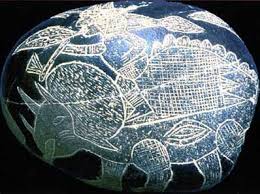 The fact that images of ancient dinosaurs, that have only recently been discovered by archeologists, should appear on stones supposedly created thousands of years ago has been hard enough for sceptics to swallow. But when more stones appeared showing human beings being devoured by dinosaurs, the entire phenomenon of the Stones of Ica became the butt of scientific ridicule. The fact that images of ancient dinosaurs, that have only recently been discovered by archeologists, should appear on stones supposedly created thousands of years ago has been hard enough for sceptics to swallow. But when more stones appeared showing human beings being devoured by dinosaurs, the entire phenomenon of the Stones of Ica became the butt of scientific ridicule.
Since the age of the dinosaurs is considered to have been terminated by an asteroid strike some 66 million years ago, and since the earliest traces of hominid man extend back in time little more than two million years, the idea of human beings interacting with dinosaurs would seem ludicrous in the extreme.
Those scientists who rejected the origin of these stones as mere opportunistic fraud, found even more to laugh about when other stones emerged showing human beings interacting with domesticated dinosaurs, as can be seen in some of the images below.
http://www.greatdreams.com/dino-man.jpg
http://www.povo.it/ars/0dot15/dinosauri1.jpg
http://martinon.wifeo.com/images/acam_dino_pe.jpg
http://creationbuff.files.wordpress.com/2007/06/ica_stone.jpg
http://farm4.static.flickr.com/3294/2851796125_da445a6b19.jpg?v=0
This review of some of the images that have been carved on the stones of Ica continues in Part Two.
Allan, The Stones of Ica, January 28, 2009, 3:01 pm
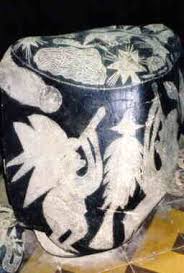 If the enigmatic stones assembled by Dr. Javier Cabrera in Ica were limited simply to dramatic images of dinosaurs, they might be easy enough to dismiss. But among the more than 11,000 stones that can be viewed in his museum are others that speak to an age of technology that rivals the marvels of our own time. If the enigmatic stones assembled by Dr. Javier Cabrera in Ica were limited simply to dramatic images of dinosaurs, they might be easy enough to dismiss. But among the more than 11,000 stones that can be viewed in his museum are others that speak to an age of technology that rivals the marvels of our own time.
In the image shown here a man can be seen studying the heavens with a telescope. Other astronomical objects are included, including a large comet that dominates the sky. Could this have been a reference to the agent of catastrophe that destroyed their world?
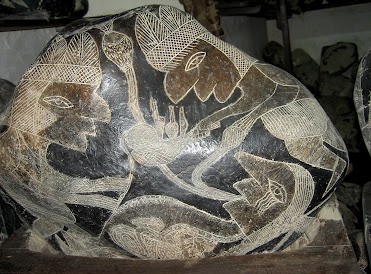 In the image on the left, two people are depicted operating on a patient, with the heart having been removed from the body. This is just one of an entire series of stones which appear to show a complete heart transplant operation. In the image on the left, two people are depicted operating on a patient, with the heart having been removed from the body. This is just one of an entire series of stones which appear to show a complete heart transplant operation.
Another in a series of stones devoted to surgical procedures shows a surgeon about to perform a caesarian section on a pregnant woman.
Another vivid stone etching appears to illustrate the continents of earth as they appear from space. None of the continents look exactly as they do today, but this scene might represent the earth as it looked in the distant past before some giant cosmic catastrophe.
http://www.viewzone.com/ica2.jpg
The images shown below are particularly interesting because they match not only the content, but the exact style of images which appear in the famous “lines” of Nazca, llocated just a few miles away from Ica.
What is significant is that the lines etched in the desert sands surrounding the town of Nazca can only be seen in their entirety from the air, and were in fact unknown to the world until they were first noticed by the Peruvian Airforce in 1956.
This suggests that the carvers of the images on the stones were the same people who etched these huge designs on the desert sand. Some of the most recognizable images of Nazca are the pictures of the “monkey”, the “tarantula” and the “humming bird”, as shown below:
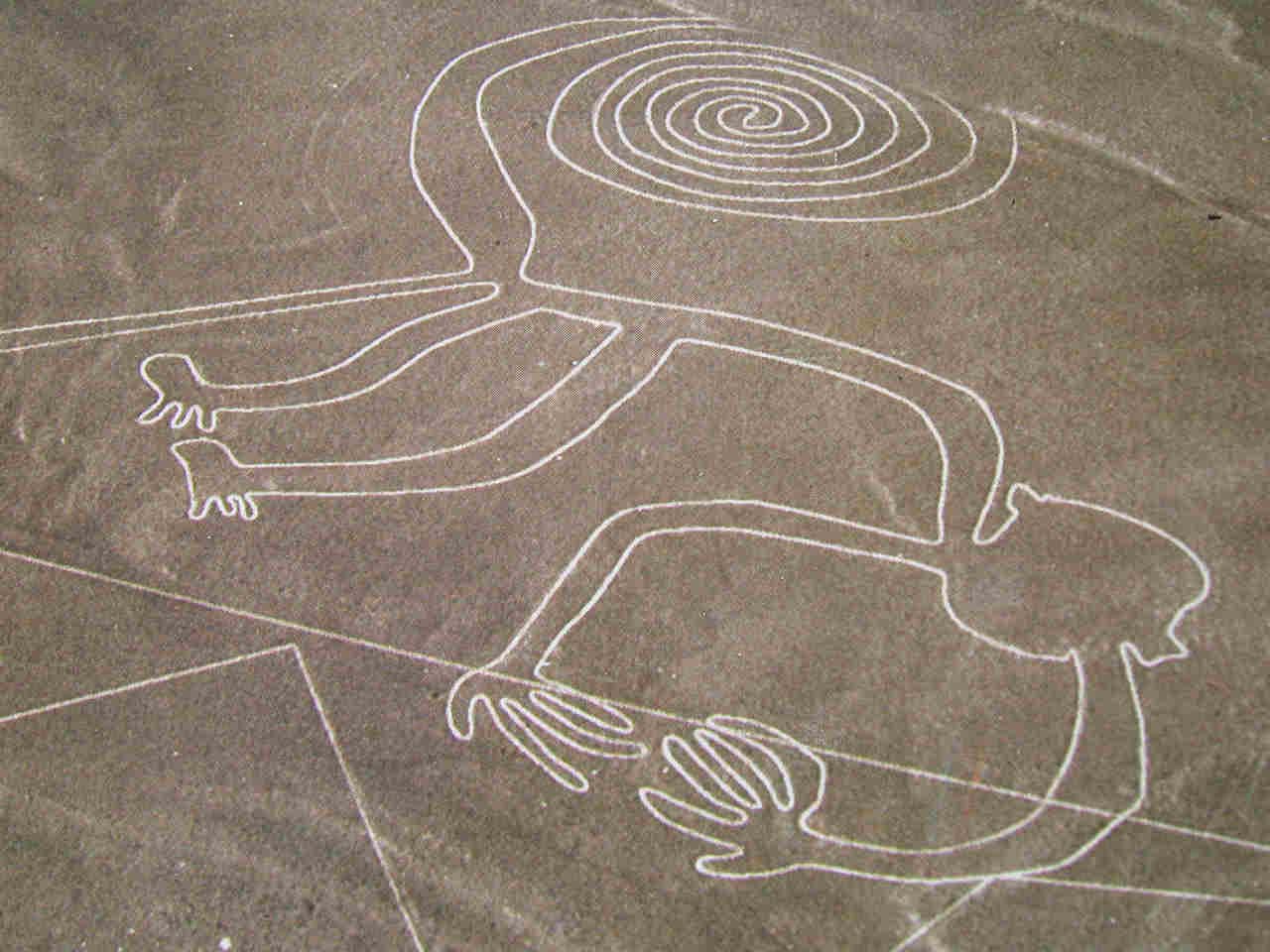
 Nazca image of tarantula  Nazca image of a bird

Similar designs to the images carved into the desert have been found on the stones of Ica, as evidenced by the example above.
Whether the stones shown above are the work of the survivors of a lost civilization is unknown. What is known is that they were found in an area that contains many unsolved mysteries indicative of a highly advanced society that might once have existed in the area.
The stones of Ica have been found close to the “lines” of Nazca which portray images that were designed to be seen from the sky. They were found in an area close to the megalithic ruins of Sacsayhuaman and Ollantaytambo. They were found in the same region as the underground tunnels discovered in Ecuador and Peru.
The problem with these enigmatic stones is that they do not fit with the accepted version of the history of humanity on this planet.
It is left to the reader to decide whether our present knowledge of history is true, or whether other civilizations may once have flourished on the earth, only to vanish without trace as a result of cataclysms in the past.
Allan, The Stones of Ica, January 27, 2009, 3:57 pm
 At first glance it may seem easy to dismiss the entire collection of engraved stones found at Ica as fakes, and accept the version put forth by the authorities that they are the work of simple artisans hoping to generate money by scamming unsuspecting tourists. At first glance it may seem easy to dismiss the entire collection of engraved stones found at Ica as fakes, and accept the version put forth by the authorities that they are the work of simple artisans hoping to generate money by scamming unsuspecting tourists.
But upon more detailed examination, this plausible tale simply does not stand up to critical analysis. The local peasant who supposedly “confessed” to creating these images could not possibly have engraved so many thousands of stones, especially when the time needed to complete such a task would exceed the lifetime of a single person.
In the book “The Last Days of Tolemac“, the Oracle explains that many thousands of years ago, a highly advanced civilization once lived in Central America. According to the book, this culture was destroyed by a series of cataclysms which caused their lands to be engulfed by the surrounding sea.
According to the Oracle, their civilisation was destroyed because it had become irretrievably corrupt. As he wrote:
“Yet despite our great accomplishments over many centuries, with the passage of time our men and women grew corrupt. They began to follow the left hand path of life. As has been the case with so many other cultures that once rose to great levels of achievement on earth, the people of Tolemac began to pursue pleasure and material wealth. Economy gave way to excess and honesty gave way to expediency. Our merchants became motivated by avarice and greed. Those in authority used their power to exploit and oppress others. Our priests turned to superstition and magic to mislead the people. Our sacred ceremonies became debased and were turned instead into mass orgies involving human sacrifice.”
“Inevitably the time came when the people of Tolemac had to face the consequences of their deeds. Great earthquakes fractured the land and hurricane winds destroyed their dwellings. Whereas the great civilization of Lemuria had taken many years before it was destroyed, and Atlantis had sunk beneath the waves within the course of a single night and a day, the final destruction of Tolemac took just thirteen hours. Entire cities were swallowed up by the ocean. Today the ruins of the cities of Tolemac lie on the seabed off the island you call Cuba.”
As we have seen from earlier entries in this Blog, evidence showing the existence of sunken cities off the coast of Cuba has now been found, and they corroborate the words of the Oracle. But this was by no means the only example of a culture that was destroyed because it had become corrupt.
According to the Old Testament of the Bible a group of five towns, known as “The Cities of the Plain” located in Southern Israel, were destroyed by brimstone and fire. These cities were named Sodom, Gomorrah, Admah, Zeboim and Bela.
As described in Chapter 18 of the Book of Genesis, Lot was warned by God that the people living in these cities would be destroyed because of their wicked ways, particularly their depraved sexual practices. The word sodomy serves as a modern reminder of the citizens of Sodom.
If the stones found at Ica were in fact carved by the survivors of an ancient civilization that had been destroyed by a series of natural disasters, then it becomes entirely feasible that these survivors would seek to preserve a history of their culture by carving crude images on the most enduring objects which lay at hand, namely local rocks made of “andesite”.
 This would explain the enormous variety of images that have been found on these stones, ranging from the history of the people who carved them to their technological achievements as well. They would also have been likely to record the culture of the times which led up to these catastrophes. This would explain the enormous variety of images that have been found on these stones, ranging from the history of the people who carved them to their technological achievements as well. They would also have been likely to record the culture of the times which led up to these catastrophes.
Seen in this light, the following images which have been found on some of the stones at Ica may be highly significant, for they show scenes of sexual activity similar to that practised in the towns of Sodom and Gomorrah.

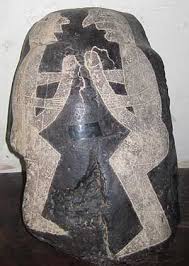
The lesson that modern researchers should perhaps learn from these stones is that human cultures rise and fall. And that societies that have fallen prey to corruption, exploitation, oppression and decay may become ripe for destruction, despite a long legacy of technological achievement.
If this is so, then these strangely carved stones of Ica could be a warning to modern man that we ourselves might be in similar peril, and that our society might also face destruction, just as others have perished in the past.
Allan, The Stones of Ica, January 26, 2009, 8:32 pm
In the book “The Last days of Tolemac”, the Oracle referred to a lost civilization of Paititi, that was located in South America in the Amazon Basin of Brazil, and which had a level of culture that rivaled both Atlantis and Lemuria. The Oracle went on to say:
“While the lost civilizations of Atlantis and Lemuria live on in legend, little is known today about the civilization of Paititi. Although this civilization co-existed with its more famous neighbors in the Atlantic and Pacific oceans, it was in some ways even more advanced.”
“The civilization of Paititi differs from those of Atlantis and Lemuria in one significant way. Whereas the islands of Atlantis and Lemuria were both destroyed by earthquakes and sank below the waves, the cities of Paititi have never been under water. Their cities remain relatively intact, while their records are preserved in underground libraries that still survive to this day. They are protected by the dense Amazonian jungle that now shields them from modern eyes.”
“The builders of Paititi also built a system of tunnels that honeycomb the region. These tunnels were not only used for transport and communication, but also for storing their precious objects and artifacts. When the earthquakes that will herald the coming of the new age cause large sections of the earth to be displaced, they will cause these tunnels to be revealed.”
Many readers have asked whether there is any truth to all of this, and if any ruins of Paititi have been discovered in the Amazon Basin of Brazil, and whether there is any evidence of a system of tunnels where their underground libraries may have been stored.
Although this is a subject that requires far more space than can be allocated here, the search for the answers to these questions dominated the lives of three enigmatic men, who between them may have glimpsed the reality that lies behind the legend of Paititi. The names of these three men were Colonel Percy Fawcett, Janos Moricz and Padre Carlos Crespi.
Allan, The Quest for Paititi, January 17, 2009, 2:07 pm
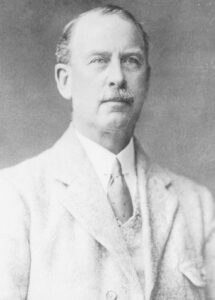 Colonel Percy Harrison Fawcett was a British archeologist and explorer. He was born in 1867 in Torquay, England. He is presumed to have died in 1925 when, along with his son and a family friend, he disappeared while on an expedition to find a legendary city lost in the uncharted regions of the Mato Grosso in Brazil. Colonel Percy Harrison Fawcett was a British archeologist and explorer. He was born in 1867 in Torquay, England. He is presumed to have died in 1925 when, along with his son and a family friend, he disappeared while on an expedition to find a legendary city lost in the uncharted regions of the Mato Grosso in Brazil.
At the time of his death, Col. Fawcett was an accomplished surveyor. He first traveled to South America in 1906 at the request of the Royal Geographical Society, in order to map the jungle areas bordering Brazil and Bolivia. Between the years 1906 and 1924 he made seven expeditions to this region.
Fawcett was a personal friend of the British authors H. Rider Haggard and Arthur Conan Doyle of Sherlock Holmes fame. It was said that it was Fawcett’s stories that were the inspiration for Doyle’s book “The Lost World”, and that his example as an adventurer and archaeologist later became the template for the screen character of Indiana Jones.
Fawcett had a passion for uncovering the mysteries of antiquity, and it was during his many expeditions to the jungle that he began to hear stories, told to him by the local Indians, of a lost city located somewhere in the Mato Grosso region of Brazil. The quest to discover this legendary city became the overwhelming obsession of his life. As he wrote in a letter to his son Brian:
“I expect the ruins to be monolithic in character, more ancient than the oldest Egyptian discoveries. Judging by inscriptions found in many parts of Brazil, the inhabitants used an alphabetical writing allied to many ancient European and Asian scripts. There are rumors, too, of a strange source of light in the buildings, a phenomenon that filled with terror the Indians who claimed to have seen it.”
“The central place I call “Z” — our main objective — is in a valley surmounted by lofty mountains. The valley is about ten miles wide, and the city is on an eminence in the middle of it, approached by a barrelled roadway of stone. The houses are low and windowless, and there is a pyramidal temple.”
 The lure of discovering this legendary city which he called “Z” became a siren song for Fawcett, as it had done for so many adventurers before him, as well as others who were drawn to that area after his death. The lure of discovering this legendary city which he called “Z” became a siren song for Fawcett, as it had done for so many adventurers before him, as well as others who were drawn to that area after his death.
Yet this legendary city has remained tantalizingly out of reach, for there is no record that Fawcett, or anyone else, has ever returned to describe the place that has fired the imaginations of so many, as may be seen from the image shown here.
In 1925 Fawcett, together with his elder son Jack and his friend Raleigh Rimmell, set out to discover the lost city of gold. Fawcett always preferred to travel light, with companions who could be relied upon to negotiate the dangers that confronted them. Small groups of people were also less likely to attract the attention of hostile Indian tribes.
On May 29th, 1925, Fawcett telegraphed his wife saying that they were ready to enter unexplored territory in the region of the Upper Xingu, a tributary of the Amazon River. He said that they had sent the rest of the party back on account of the dangers posed by the local Indians, and that just the three of them would be going on. His message ended with the words; “You need have no fear of failure.”
This was the last that anyone heard of the expedition. The three men vanished into the jungle and w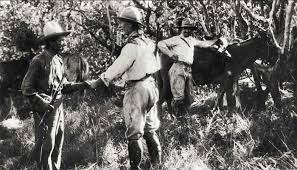 ere never heard from again. ere never heard from again.
No sooner had the group disappeared than rumors of their fate began to circulate. Some thought they had met their death at the hands of the Indians, while others were convinced they had died of disease or fallen prey to wild animals.
Percy Fawcett’s son Brian made two trips to the area to try to solve the mystery of their disappearance, but returned without success. But stories of a lost city of antiquity hidden deep in the jungles of the Mato Grosso continue to persist, and in the decades that have followed, more than a hundred people have lost their lives in their quest to find this lost city of Paititi.
Yet the haunting thought remains. Could Percy Fawcett actually have succeeded in finding his city of “Z” after all, but was prevented from leaving by the local Indians who guarded the site? Up to the time of her death, Fawcett’s wife remained convinced that her husband had achieved his goal, and had lived for many years in the city of his dreams.
Perhaps we shall never know, for the existence of this lost city has until now remained hidden in the mists that shroud the jungles of the Mato Grosso. These jungles guard their secrets well, for as the Oracle of Tolemac has written:
“Until that time when the world is ready to rediscover the lost science of Paititi their secrets will remain protected by the jungle, poisonous reptiles and hostile Indian tribes, who are the modern guardians of this ancient knowledge.”
The world might have forgotten about the hoary legends of Paititi if it had not been for the tales of a Swiss hotelier who visited South America in 1972, and met with a reclusive man with a sensational story to tell. The name of the Swiss writer was Erich von Däniken, and the man that he met was Juan Moricz.
At the time of their meeting Erich von Däniken was a successful author with a provocative theme. He had already published two books which had captured the popular imagination of the world and become instant best-sellers. These books were “Chariots of the Gods” and “Return to the Stars”.
While most scholars and scientists scorned his theories of “ancient astronauts”, von Däniken was nevertheless successful in drawing the attention of the world to ancient relics and ruins that defied the traditional explanation of the history of humanity. In his book entitled “The Gold of the Gods”, von Däniken described why he had arranged to meet with Moricz.
Allan, The Quest for Paititi, January 16, 2009, 11:15 pm
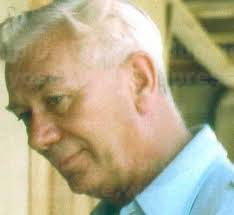 Juan Moricz was born in Hungary, but later moved to South America where he became an Argentine citizen. However, at the time of his meeting with von Däniken, he had been living in Ecuador for many years. He described himself as a scholar who was carrying out research into the folklore and the ethnological and linguistic aspects of native Ecuadorian tribes. Juan Moricz was born in Hungary, but later moved to South America where he became an Argentine citizen. However, at the time of his meeting with von Däniken, he had been living in Ecuador for many years. He described himself as a scholar who was carrying out research into the folklore and the ethnological and linguistic aspects of native Ecuadorian tribes.
In the course of his fieldwork, Moricz claimed to have stumbled across a network of underground tunnels in June, 1965. These tunnels seemed clearly man-made, but they appeared to have been constructed by a culture that was unknown to archeologists in the region.
In a notarized Title Deed in which he claimed to be the discoverer of these subterranean tunnels, Moricz stated that he had also found “objects of great cultural and historical value to mankind”.
These objects consisted of “stone and metal objects of different sizes and colors”, as well as “metal plaques (leaves) engraved with signs and writing”. What Moricz did not indicate in the Title Deed, and which immediately captured the attention of von Däniken, was that these metal plaques and objects appeared to have been made of solid gold.
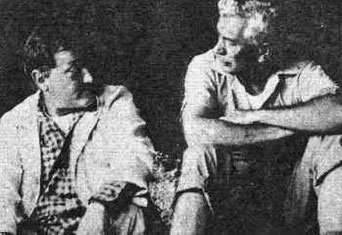 In his book “The Gold of the Gods” von Däniken described how Moricz had taken him to the location of these tunnels, and had led him to a vast underground chamber some 750 feet below the ground, which was clearly artificially carved out of the rock. In his book “The Gold of the Gods” von Däniken described how Moricz had taken him to the location of these tunnels, and had led him to a vast underground chamber some 750 feet below the ground, which was clearly artificially carved out of the rock.
This chamber, measuring about 450 feet by 500 feet in size, had highly glazed walls together with a smooth floor and ceiling. In the middle of this chamber was an enormous table around which were set seven chairs made of an unusual material resembling plastic.
Forming a perimeter around the table and chairs were numerous sculptured animals. These animals included some that were indigenous to the region, such as monkeys and jaguars. But there were others which were totally foreign to the area, such as lions, wolves, elephant and bison.
As von Daniken later wrote: “The whole thing was like a fantastic zoo and what is more all the animals were made of solid gold.”
But the most significant feature of the chamber was a “library” comprising thousands of metal plates. Each plate was 38 inches high, 19 inches wide, and 1/16th of an inch thick. Yet each of these plates was so sturdy that they stood rigidly in place without bending.
This combination of sheets appeared to be an extensive library, for each of these metal sheets was similar in character. Each sheet was stamped with line after line of unusual symbols in a form of hieroglyphic writing.
Erich von Daniken attempted to take photographs of these metal sheets as well as the other golden objects. However, Moricz prevented him from doing so, perhaps fearing what the publicity of a popular author like von Däniken might bring.
He did however agree to introduce him to an elderly Salesian monk who lived nearby in Cuenca. The name of this pious monk was Padre Carlos Crespi.
Allan, The Quest for Paititi, January 15, 2009, 12:35 pm
 Padre Carlos Crespi was born in Italy in 1891. He joined the Salesian Society, a Roman Catholic religious order, and was sent to minister to the people of Ecuador. Padre Crespi dedicated his life to the service and welfare of the people of Ecuador, both rich and poor alike. Padre Carlos Crespi was born in Italy in 1891. He joined the Salesian Society, a Roman Catholic religious order, and was sent to minister to the people of Ecuador. Padre Crespi dedicated his life to the service and welfare of the people of Ecuador, both rich and poor alike.
He was a man of extraordinary benevolence and talent. Up to the time of his death in 1982, he served as educator, anthropologist, botanist, artist, explorer and musician. Following his death a statue was erected in the city of Cuenca to commemorate his long years of service to the community.
Over the years Padre Crespi gained the confidence of the local Indian tribes. To repay him for his kindness, they would bring him ancient artifacts. When asked where they had found them, they would simply say that they came from under the ground.
During the course of his ministry Padre Crespi assembled a considerable collection of ancient objects, and stored them at the Church of Maria Auxiliadora at Cuenca. It was there that he and von Däniken met.
 Padre Crespi invited von Däniken to examine his vast store of treasures, which he kept in various rooms. One room was devoted to carved stones. Another room contained Inca artifacts of gold, silver, copper and brass. A third room contained artifacts that were similar to the objects that von Däniken had seen in the underground cavern that he had explored with Juan Moricz. Padre Crespi invited von Däniken to examine his vast store of treasures, which he kept in various rooms. One room was devoted to carved stones. Another room contained Inca artifacts of gold, silver, copper and brass. A third room contained artifacts that were similar to the objects that von Däniken had seen in the underground cavern that he had explored with Juan Moricz.
This time von Däniken was allowed to photograph these golden objects, and it was these photographs that appeared in his book “The Gold of the Gods”.
The objects in Father Crespi’s collection were an archeologist’s dream. Not only were they made of gold, but they had a historical value beyond price. If there is anything that can serve to validate the existence of the civilization of Paititi, it is this collection acquired by Padre Crespi.
The showpiece of his collection is a sheet of metal, 20½ inches high, 5½ inches wide, and 1½ inches thick. This weight of this metallic plaque is about 44 pounds.
It would be impossible to place a price on this unique plaque which deserves to be enshrined in one of the great museums of the world.
But what makes this plaque of supreme importance to archeology is that it is imprinted with 56 different characters, arranged in groups of four. These characters are completely unknown to scholars, and up to this time these “letters” have never been deciphered. They could not have been created by the Incas, since the Incas had no recorded form of writing. In a strange way, these “letters” seem bear out what Percy Fawcett had described in his letter to his son Brian, quoted above:
“Judging by inscriptions found in many parts of Brazil, the inhabitants used an alphabetical writing allied to many ancient European and Asian scripts.”
In fact the “letters” have been compared to a cross between the characters used by the Magyars of the Carpathian Mountains in Europe, and the ancient Sumerians. This suggests that whatever culture was responsible for creating this metallic plaque could have been the same civilization that “seeded” these ancient cultures in Europe and Asia.
The 56 characters of this metallic plaque are shown below.
 In In the Title Deed referred to above, Juan Moricz claimed to have found “metal plaques (leaves) engraved with signs and writing”, in a large underground cavern accessed by the subterranean tunnels that he had discovered. In In the Title Deed referred to above, Juan Moricz claimed to have found “metal plaques (leaves) engraved with signs and writing”, in a large underground cavern accessed by the subterranean tunnels that he had discovered.
When Moricz agreed to guide von Däniken to his secret treasure trove, they entered the tunnels which led to this large underground cavern. It was here that von Däniken saw for himself the vast “library” of these metal leaves. The entire library amounted to several thousand “leaves”, of which the panel shown above is just one example.
Could it be that the plaque shown above is the key to deciphering all the leaves in the library? Obviously we will never know until the entire library becomes available for scientific study and analysis.
But Padre Crespi’s golden collection was not limited to this plaque, as unique and important as it undoubtedly is. There were also a vast range of other objects, of which the items shown below are just a few examples.
Entire Volumes could no doubt be written about each one of the above objects. Padre Crespi never tried to classify or interpret them. Their age and origin is still unknown. Their picture motifs are strange and their meaning has yet to be deciphered.
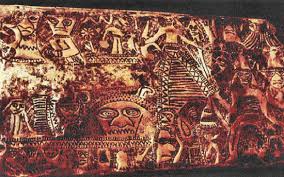 It is hoped that one day these artifacts will get the attention and research that they deserve. Unfortunately, that day does not seem likely to dawn any day soon. It is hoped that one day these artifacts will get the attention and research that they deserve. Unfortunately, that day does not seem likely to dawn any day soon.
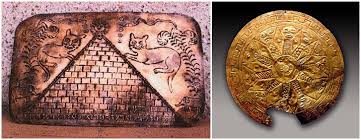
Many of these priceless objects were destroyed when the Church was severely damaged by fire. Others disappeared when the Church buildings were restored. After Padre Crespi died the remaining artifacts were removed and are no longer accessible to the public.
It seems as if the prediction made by the Oracle of Tolemac is correct, and that these objects will remain hidden until the time when the world is ready to benefit from the ancient wisdom of Paititi.
The quest for the evidence of Paititi will be continued when we investigate in greater detail the mysterious subterranean tunnels discovered by Juan Moricz, and the subsequent expeditions that were made to discover the “stone and metal objects” that Moricz claimed lay hidden in vast underground caverns.
Allan, The Quest for Paititi, January 14, 2009, 12:36 am
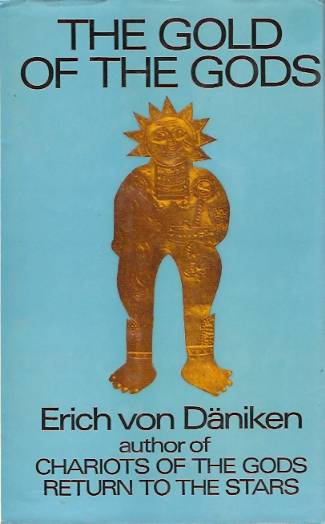 When Erich von Däniken published his book “The Gold of the Gods” in 1972, it quickly became an international best seller. By far the most sensational and controversial chapter in the book was his description of his visit to an underground cavern in the Andes Mountains of Ecuador, in which he claimed to have seen a vast collection of golden artifacts that were considered to be the products of some long forgotten civilization that had once existed in the area. When Erich von Däniken published his book “The Gold of the Gods” in 1972, it quickly became an international best seller. By far the most sensational and controversial chapter in the book was his description of his visit to an underground cavern in the Andes Mountains of Ecuador, in which he claimed to have seen a vast collection of golden artifacts that were considered to be the products of some long forgotten civilization that had once existed in the area.
In his book von Däniken described how he had been guided to the location of this underground chamber by a man who had lived for many years in Guayaquil in Ecuador. He not only identified the man who claimed to have discovered these subterranean tunnels as Juan Moricz, but gave detailed instructions on how he could be traced.
Juan Moricz was a reclusive man who had always shunned publicity. Now, as a result of the publication of von Däniken’s book, he found that he was the object of a world wide search to discover the location of this collection of golden artifacts, and the Metal Library that von Däniken had described. Not surprisingly, Moricz now told a different tale.
When reporters of Europe’s most influential weekly magazine “Der Spiegel” tracked him down, Moricz denied having ever taken von Däniken to an underground cavern. When these comments were subsequently published, this retraction by Moricz served to undermine von Däniken’s credibility, and implied that his entire story was a fraud.
The ensuing uproar led one man to undertake a scientific expedition to Ecuador to try to establish the truth of the story, and to find this elusive library of metal plates. This man was a Scottish engineer by the name of Stanley Hall. Hall had read von Däniken’s book and he traveled to Ecuador to meet with Juan Moricz.
Moricz finally admitted to Hall that he had in fact met with von Däniken in 1972, and had taken the Swiss author from Guayaquil to Cuenca to meet with Padre Crespi to see his collection of golden artifacts. He also confirmed that he had taken von Däniken to visit a nearby cave system called “Cueva de los Tayos”.
 “Cueva de los Tayos“, or to give it its English translation, means “Cave of the Oilbirds“. This subterranean cave system takes its name from the numerous buzzard-like birds that make their homes in these caverns, and fly in and out of the ventilation shafts. “Cueva de los Tayos“, or to give it its English translation, means “Cave of the Oilbirds“. This subterranean cave system takes its name from the numerous buzzard-like birds that make their homes in these caverns, and fly in and out of the ventilation shafts.
It was to this system of underground caves that Juan Moricz agreed to guide Stan Hall and his scientific expedition.
Allan, The Tunnels of the Andes, January 13, 2009, 10:20 am
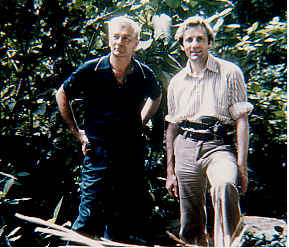 It was in 1976 that Stan Hall, guided by the Ecuadorian explorer Juan Moricz, organized an expedition to survey the entire cave system of “Cueva de los Tayos”. This expedition was a joint British/Ecuadorian venture, and included a team of geologists and botanists as well as one hundred soldiers of the Ecuadorian army, whose task it was to provide security. It was in 1976 that Stan Hall, guided by the Ecuadorian explorer Juan Moricz, organized an expedition to survey the entire cave system of “Cueva de los Tayos”. This expedition was a joint British/Ecuadorian venture, and included a team of geologists and botanists as well as one hundred soldiers of the Ecuadorian army, whose task it was to provide security.
Searching for a distinguished patron who could provide credibility to the whole enterprise, Hall approached a man who had strong Scottish connections. To his surprise and delight, this man agreed to accompany them on the expedition.
The name of this man was Neil Armstrong, the first man to walk upon the moon. By an unusual twist of fate, the story which had begun with an author famed for his theory of “ancient astronauts”, now involved the most famous astronaut of them all.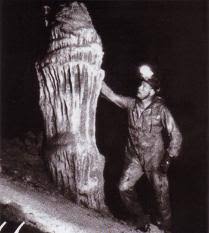
During the three weeks that his team remained on site to investigate these subterranean caverns, Stan Hall was unable to find any trace of the Metal Library. His team did however find a seated body in a burial chamber inside the cave that was dated to 1,500 B.C.
Juan Moricz originally collaborated with Hall and agreed to help him search for the Metal Library that supposedly lay hidden within these caverns. But when it became apparent that it was Hall who would gain the glory if this library was discovered, Moricz abruptly terminated all dealings with him.
Juan Moricz never again discussed in public his association with the Metal Library, and he refused to divulge the exact location of the entrance to the subterranean tunnels. He died in February 1991, taking his secret with him to the grave.
 Sadly, the possibility of anyone else finding this Metal Library via the “Cueva de los Tayos” has also ended. When the Ecuadorian authorities realized that ancient golden artifacts might be found within this cave system, a Government seal was placed at the entrance. It has been permanently guarded ever since. Sadly, the possibility of anyone else finding this Metal Library via the “Cueva de los Tayos” has also ended. When the Ecuadorian authorities realized that ancient golden artifacts might be found within this cave system, a Government seal was placed at the entrance. It has been permanently guarded ever since.
Although the Hall expedition failed in its attempt to discover the Metal Library, it did establish beyond doubt that an extensive system of underground tunnels did exist, and that these tunnels were artificially constructed. In fact they looked exactly like the description that von Däniken had given in his book “The Gold of the Gods”.
“The passages all form perfect right angles. Sometimes they are narrow, sometimes wide. The walls are smooth and often seem to be polished. The ceilings are flat and at times look as if they were covered with a kind of glaze.”
 The rumors of artificial tunnels that existed deep beneath the ground did not begin with Juan Moricz. Soon after Francisco Pizarro and his band of conquistadores arrived in Peru in 1532, stories began to circulate about hoards of golden treasure that had been hidden by the Incas in a vast network of underground tunnels. It did not take long for these rapacious hunters of gold to search for these underground hiding places. The rumors of artificial tunnels that existed deep beneath the ground did not begin with Juan Moricz. Soon after Francisco Pizarro and his band of conquistadores arrived in Peru in 1532, stories began to circulate about hoards of golden treasure that had been hidden by the Incas in a vast network of underground tunnels. It did not take long for these rapacious hunters of gold to search for these underground hiding places.
While exploring Huascaran, the highest mountain in Peru and a place that was revered by the Incas, a Spanish force discovered a cave whose interior was blocked off by large slabs of rock. Although they suspected that these stone blocks might conceal a hidden storage room beyond, they were unable to gain access to it. However the story was recorded by one of the chroniclers who accompanied the group.
It was not until 1971 that a well-equipped expedition was organized to investigate the site. This expedition consisted of speleologists equipped with all the necessary technical support. At the far end of the cave, they found six water-tight doors made of enormous blocks of stone. But despite their tremendous weight, these doors were pivoted in such a way that four men were able to push them open.
Beyond these doors lay a system of tunnels that had been carved out of the rock. According to a report in the German periodical “Bild der Wissenschaften” which covered this expedition, the floors of these tunnels were pitted and grooved to make them slip-proof. They descended downwards at an angle and led straight towards the coast, a distance of some sixty miles away.
Where these tunnels finally ended proved impossible to tell, for they appeared to continue on under the sea heading in the direction of the island of Guanape, located a short distance off the coast. What astonished the members of the expedition was that the air in these tunnels was breathable, indicating that a source of fresh air somehow existed in the tunnels.
Allan, The Tunnels of the Andes, January 12, 2009, 1:16 pm

Located on a hill overlooking the Inca capital of Cuzco are the ruins of a vast prehistoric fortress called Sacsayhuaman. This fortress is one of the most imposing feats of construction in the history of the world. It has been built out of gigantic blocks of stone, some of which weigh up to 200 tons (400,000 pounds). Yet these enormous blocks of stone were cut, dressed and fitted together without any form of mortar.
When the Spanish first arrived in Cuzco and saw these structures, they considered that they had been built by the Devil himself, because of their unprecedented size. When they explored the site, they found that it was laced with a network of tunnels that led under the ground. They called these tunnels chincanas.
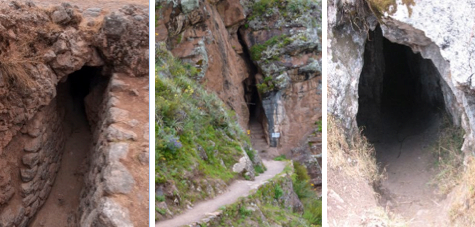
The famous chronicler Garcilosa de la Vega, who arrived shortly after the conquest of Peru, described these tunnels in the following words:
“An underground network of passages, which was as vast as the towers themselves, connected them with one another. This was composed of a quantity of streets and alleyways which ran in every direction, and so many doors, all of them identical, that the most experienced men dared not venture into this labyrinth without a guide, consisting of a long thread tied to the first door, which unwound as they advanced.”
In his book “Jungle Paths and Inca Ruins“, Dr. William McGovern wrote:
“Near this fortress [Sacsayhuaman] are several strange caverns reaching far into the earth. Here altars to the Gods of the Deep were carved out of the living rock, and the many bones scattered about tell of the sacrifices which were offered up here. The end of one of these caverns, Chincana, has never been found. It is supposed to communicate by a long underground passage with the Temple of the Sun in the heart of Cuzco. In this cavern is supposed, and with good reason, to be hidden a large part of the golden treasure of the Inca Emperors which was stored away lest it fall into the hands of the Spaniards. But the cavern is so huge, so complicated, and its passages are so manifold, that its secret has never been discovered.”
“One man, indeed, is said to have found his way underground to the Sun Temple, and when he emerged, to have had two golden bars in his hand. But his mind had been affected by days of blind wandering in the subterranean caves, and he died almost immediately afterwards. Since that time many have gone into the cavern-never to return again. Only a month or two before my arrival the disappearance of three prominent people in this Inca cave caused the Prefect of the Province of Cuzco to wall in the mouth of the cavern, so that the secret and the treasures of the Incas seem likely to remain forever undiscovered.”
The entrances to some of these tunnels can still be seen today among the ruins above the fortress of Sacsayhuaman, and visitors are allowed to view them, as described on the following website.
Allan, The Tunnels of the Andes, January 11, 2009, 11:55 am
Although the full extent of this network of underground tunnels may never be known, there are grounds for believing that it extended far into the interior, perhaps as far as the Amazon Basin in Brazil.
 In 1681, a Jesuit missionary named Fray Lucero wrote about the information that had been given to him by Indians in the Rio Huallagu area of northeastern Peru. They told him that the lost city of Gran Paititi lay behind the forests and mountains east of Cuzco. The Jesuit wrote: In 1681, a Jesuit missionary named Fray Lucero wrote about the information that had been given to him by Indians in the Rio Huallagu area of northeastern Peru. They told him that the lost city of Gran Paititi lay behind the forests and mountains east of Cuzco. The Jesuit wrote:
“This empire of Gran Paytite has bearded, white Indians. The nation called Curveros, these Indians told me, dwell in a place called Yurachuasi or the ‘white house.’ For king, they have a descendant of the Inca Tupac Amaru, who with 40,000 Peruvians, fled far away into the forests, before the face of the conquistadors of Francisco Pizarro’s day in AD 1533.”
“He took with him a rich treasure, and the Castilians who pursued him fought each other in the forests, leaving the savage Chuncho Indios, who watched their internecine struggles, to kill off the wounded and shoot the survivors with arrows. I myself have been shown plates of gold and half-moons and ear-rings of gold that have come from this mysterious nation.”
This story is independently documented in the book “Amazonas y El Maranon” by Fray Manuel Rodriguez, published in 1684, according to the author Harold Wilkins.
But whether or not the tunnels located in Peru actually extend as far as the Brazilian interior, there is certainly evidence of an opening to an underground tunnel that begins in Brazil, not far from Rio de Janeiro, and travels many hundreds of miles towards the mountains in the west.
Allan, The Tunnels of the Andes, January 10, 2009, 12:57 pm
 São Thome das Letras (Saint Thomas of the Letters) is a well known tourist resort located in the Brazilian state of Minas Gerais, roughly midway between the cities of Sao Paulo and Belo Horizonte. Being situated on top of a mountain it has excellent views of the surrounding countryside, and it enjoys a climate that is cooler than the coastal cities. São Thome das Letras (Saint Thomas of the Letters) is a well known tourist resort located in the Brazilian state of Minas Gerais, roughly midway between the cities of Sao Paulo and Belo Horizonte. Being situated on top of a mountain it has excellent views of the surrounding countryside, and it enjoys a climate that is cooler than the coastal cities.
Most visitors come to the area to take advantage of its many hiking trails, its restaurants and its artists’ colony. But others come to explore another well-known feature, which is the entrance to a mysterious system of underground tunnels.
The entrance is located at the northern edge of the town. This man-made tunnel is open to visitors, who are free to travel inside the tunnels as far as they wish. According to the local inhabitants, nobody knows who built the tunnel or where it goes.
At one point a team from the Brazilian army entered the tunnel to find out how far it extended. After traveling for four days inside the tunnel, the Army explorers came to a large room deep underground. Extending from this room were three other tunnels, each traveling in a different direction.
The Army group used this central room as a base, and set out to explore each of the other three tunnels. In no case did any of these other tunnels reach a destination. They simply carried on for mile after mile underneath the ground. Finally, unable to establish how far any of these tunnels went or where they ended, the group returned to their point of origin at São Thome das Letras.
A recent visitor who ventured into the tunnel described it as follows:
“The entrance was quite large. It was a wide mouth of a cave with a mound of dirt creating a small hill over the entrance. The cavern entrance faced to the west and immediately began running down hill, into the earth. The tunnel/cavern would have to go downhill, as we were essentially on top of a mountain.”
“With our flashlights in hand, we entered the cavern. Within a few meters, the cavern entrance narrowed into a tunnel which was about three meters (9 feet) high and two meters wide. The tunnel was dug out of dirt, and was not cut out of solid rock, as some tunnels are.”
“The tunnel headed downward at a steady slope, but it was not too steep. At no point was it ever necessary to duck, stoop or crawl in this tunnel. Quite the opposite, it was quite wide and high, even for the tallest man to walk through, even someone who was, say, seven feet tall!”
“I was amazed at this ancient feat of engineering. We were descending down into the earth in a wide, gradually sloping tunnel that was dug into a red, clay-type dirt. It was not the smooth, laser-cut rock walls that Erich von Daniken had claimed to have seen in Ecuador in his book “Gold of the Gods”, but it was just as incredible.”
” The tunnel was not perfectly straight, but wound left and right and occasionally dropped down a few feet and continued on. It was perfectly dry and the air was fresh and breathable.” (Quoted from the article Subterranean Tunnels & the Hollow Earth : Source: Biblioteca Pleyades)
This first person account validates the existence of these tunnels, and gives credence to local legends that link these tunnels with the ancient Inca fortress of Machu Picchu in Peru.
What can no longer be contested is that the modern lands of Brazil, Bolivia, Peru, Ecuador and Chile are riddled with underground tunnels that owe their origin to a culture that predates anything that is known in accepted history.
This culture seems likely to have been far superior in technology to anything that forms part of the fabric of Meso-American cultures like the Aztecs, the Incas or the Mayas. For this unknown culture was built on a scale that dwarfs the achievements of these tribes, involving megaliths of a size that cannot be replicated to this day.
Allan, The Tunnels of the Andes, January 9, 2009, 3:31 pm
Just as was the case in the Political and Economic arenas, so the year of 2008 was characterized by a continuing series of weather related disasters that caused widespread loss of life, together with devastating economic consequences.
 These disasters followed in such quick succession that the average citizen would be hard pressed to name a few, let alone the majority of the events that occurred. These disasters followed in such quick succession that the average citizen would be hard pressed to name a few, let alone the majority of the events that occurred.
Taken as a whole these weather events serve as a grim reminder that we live in times of extreme climatic change which now imperils the population of the entire planet. They act as a “Global Warning” that our island home in space is in a state of severe crisis.
January 2008
- Tropical Cyclone Gene in the South Pacific
- Extreme cold in China and Tajikistan
- Volcanic eruptions in Chile, Colombia and Ecuador
- Severe flooding in Brazil and Tanzania
February 2008
- Earthquake in the Great Lakes region of Rwanda
- Cyclone Ivan in Madagascar
- Floods in the Phillippines, Ecuador and Peru
March 2008
- Cyclone Jokwe in Mozambique
- Floods in Argentina, Paraguay and Kazakhstan
April 2008
- Typhoon Neoguri in China
- Volcanic eruption in Colombia
- Floods in Sri Lanka
May 2008
- Tropical Cyclone Nargis in Myanmar
- Tropical Cyclone Halong in Phillippines
- Earthquake in Sichuan province of China
- Earthquake in Colombia
- Volcanic eruption in Chile
- Floods in Colombia, Chile and China
June 2008
- Typhoon Fengshen in SE Asia
- Severe flooding in Nicaragua, Bangladesh, India, Surinam and the Phillippines
July 2008
- Hurricane Dolly in the USA
- Typhoons Fung-Wong and Kalmaegi in Asia
- Landslides in Guatemala and Nepal
- Floods in West Africa and Central Europe
August 2008
- Hurricane Hanna and Gustav in the USA
- Typhoon Nuri in the Phillippines
- Earthquake in the Sichuan Province of China
- Earthquake in the Yunnan Province of China
- Floods in West Africa, Sudan, and Pakistan
September 2008
- Hurricanes Ike and Kyle in the USA
- Typhoons Mekkhala, Jangmi, Hagupit, Sinlaku in Asia
- Earthquake in Iran
- Floods in Chile, Panama, Phillippines, Uganda, Nepal, Guatemala and Nepal
- Droughts in Paraguay and Syria
October 2008
- Hurricane Norbert in Mexico
- Hurricane Omar in the Carribbean
- Earthquakes in Pakistan, Russia, China & Kyrgyztan
- Floods in Sudan, Morocco, Yemen, Sri Lanka, Central America, Sri Lanka, Burundi, Rwanda, Somalia, Kenya and Algeria
November 2008
- Hurricane Paloma in the Carribbean
- Tropical Cyclone Nisha in Asia
- Volcanic eruptions in Colombia
- Earthquake in Indonesia
- Floods in Brazil, Costa Rica, Panama, Cuba, Ethiopia and the Phillippines
December 2008
- Earthquakes in China and Indonesia
- Floods in Guyana, Malaysia and the Pacific Islands
Allan, Signs of the Times, January 8, 2009, 11:13 pm
 As the year 2008 passes into history, there seems to be a collective sigh of relief around the planet. For 2008 has been witness to turmoil and tragedy, and the greatest economic crisis around the globe since the days of the Great Depression. As the year 2008 passes into history, there seems to be a collective sigh of relief around the planet. For 2008 has been witness to turmoil and tragedy, and the greatest economic crisis around the globe since the days of the Great Depression.
People everywhere hunger for change. They are searching for a new way of living, and an escape from the trauma that is relentessly stalking them. The election of Barack Obama as the next President of the United States is being universally welcomed as a sign of this change. And upon his shoulders lies the burden, not only of an entire nation, but also of a grieving world.
But it is unlikely that one man, no matter how noble his intent or how worthy his goal, can protect a nation or a world from the troubles that now encompass them. For the reason is that the true causes of these world-wide problems lie deep within the human heart, and not within the political institutions and economies of the varied countries of the world.
We do not need a re-appearance of the Buddha to know that anger and hatred lead inevitably to violence, and that violence met with yet more violence leads inevitably to war. Nor do we need a return of the Prince of Peace to point out that avarice and greed lead inevitably towards corruption, exploitation and destruction.
The year of 2008 has seen evidence of all these human failings spread wide upon the surface of the planet. People everywhere have suffered loss. Many have lost their lives. Others have lost their jobs or their pensions. The values of investments world-wide have tumbled with the collapse of Corporations, and the steep decline of Stock Markets across the globe.
2008 has been a year that has witnessed the bankruptcy of some of the largest financial companies of the world, with losses so large that the future wealth of nations has been pledged to staunch the bleeding. No one knows how long these losses will continue, or how low the Stock Markets will descend.
We live in a world of uncertainty and change, and the speed of this change seems ever more remorseless. The moving minute seems to have been replaced by the moving second, and each new moment seems filled with new and frightening challenges.
Yet all this has been predicted long ago, and the alarming events of modern times are no more than the unfolding of an ancient plan. There is a purpose to our lives, and a reason for our suffering. That purpose is to learn, and those who do will rise phoenix-like from the fires of the dying of the age.
This Piscean Age of misery is in its final death-throes. It will shortly pass into history amidst the calamities and catastrophes that have long been foretold. In the book “The Last Days of Tolemac”, the Oracle of Tolemac sets out the events that will shortly come to pass.
Perceptive people everywhere can see the signs of this imminent destruction. As far back as 1945, the great American novelist and painter Henry Miller wrote:
“A new world is being born, a new kind of man is springing up today. The great mass of mankind, destined in our time to suffer more cruelly than ever before, ends by being paralysed with fear, becoming introspective, shaken to the very core, and does not hear, see or feel anything more than everyday physical needs.”
“It is thus that worlds die. First and foremost, the flesh dies. But although few clearly recognize it, the flesh would not have died if the spirit had not been killed already.”
Allan, Signs of the Times, January 4, 2009, 3:49 pm
According to the Oracle of Tolemac, in the days leading up to the return of the Christ, the Jews will rebuild the Temple of Solomon on its original site on Mount Moriah. This new Temple will once again become the central focus of Jewish worship, and the place where their ancient practice of animal sacrifices will be resumed.
What makes this prediction seemingly impossible at this time is that the site on which Solomon constructed his original temple is also one of the holiest places in the Islamic religion. For it was on this site that Muslims believe that the Prophet Muhammad ascended into Heaven, accompanied by the angel Gabriel.

To commemorate this event, the Muslims built a golden shrine called “The Dome of the Rock” in 691 AD. Close to this shrine and on the same platform of stone, they also erected the Al-Aqsa Mosque. Both of these buildings have since become integral features of the Islamic faith.
Although the Israeli flag was hoisted above the Dome of the Rock for a few hours in 1967, following the capture of Jerusalem by the Israelis in the Six-Day War, it was lowered on the orders of General Moshe Dayan, in order to avoid offending Muslims and to preserve peace.
Today the entire Temple Mount area is owned and maintained by the Ministry of Awqaf in Jordan. Although non-Muslims are now permitted to visit the Temple Mount during certain times, they are prohibited from entering these Muslim shrines.
However, this access does not apply to Orthodox Jews, and Jewish visitors are warned that entry to the Temple Mount is a violation of the Torah. This is because the entire area is regarded as sacred ground, as it once housed the “Holy of Holies” of the Temple of Solomon.
In the face of these obstacles, it would seem impossible for the prediction of the Oracle of Tolemac to be fulfilled under the existing circumstances. Any attempt by the Jews to rebuild the Temple of Solomon on the same site as these Islamic shrines would spark a religious conflict that could lead to nuclear war.
Yet in the book “The Last Days of Tolemac”, the Oracle not only predicts that the Jews will rebuild this Temple on its former site, but he also outlines the circumstances under which this will take place. What makes this prophecy especially significant is that the materials needed to construct the building and its contents have already been prepared.
In 1987, a non-profit educational and religious organization was founded in Israel. It was located in the Jewish quarter of the Old City of Jerusalem. This organization was called The Temple Institute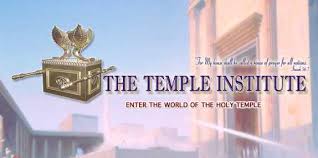 . .
The founder of the Institute is Rabbi Yisrael Ariel. Rabbi Ariel is a distinguished scholar and author of many Hebrew works. He also served in the paratrooper brigade which liberated the Temple Mount in the Six-Day War of 1967, and was one of the first soldiers to reach the Mount.
The central purpose of the Institute is to rebuild the Temple on the original site of Mount Moriah, and restore the ancient practice of animal sacrifices as set out in the Torah. According to the Statement of Principles outlined on its website, the objectives of the Temple Institute are as follows:
“The Institute is dedicated to every aspect of the Biblical commandment to build the Holy Temple of G-d on Mount Moriah in Jerusalem. Our short-term goal is to rekindle the flame of the Holy Temple in the hearts of mankind through education. Our long-term goal is to do all in our limited power to bring about the building of the Holy Temple in our time.”
“The major focus of the Institute is its efforts towards the beginning of the actual rebuilding of the Holy Temple. Towards this end, the Institute has begun to restore and construct the sacred vessels for the service of the Holy Temple. These vessels, which G-d commanded Israel to create, can be seen today at our headquarters in Jerusalem.”
“They are made according to the exact specifications of the Bible, and have been constructed from the original source materials, such as gold, copper, silver and wood. These are authentic, accurate vessels, not merely replicas or models. All of these items are fit and ready for use in the service of the Holy Temple.
Among the many items featured in the exhibition are musical instruments played by the Levitical choir, the golden crown of the High Priest, and gold and silver vessels used in the incense and sacrificial services.”
The Temple Institute has also conducted intensive research into the exact dimensions of the original Temple of Solomon so that, when the time comes, the new Temple will be an exact replica of the original building. The central focus of worship in the new Temple will be the Sanctuary, which will contain the Menora and other holy ritual objects.
At the far end of the Sanctuary will be the “Holy of Holies”, or the Inner Sanctuary of the Tabernacle. At the time of Solomon, the Inner Sanctuary was hidden by a veil, and entry was forbidden to everyone but the High Priest, and even he was only permitted to enter it on one day of the year.
At the time of the original Temple built on Mount Moriah by Solomon, the Inner Sanctuary was kept in total darkness. The entry of the High Priest into the Inner Sanctuary of the Tabernacle took place on the “Day of Atonement” (Yom Kippur), which is the holiest day in the Jewish calendar.
According to tradition, the Inner Sanctuary contained the Ark of the Covenant, in which were placed the stone tablets on which were inscribed the Ten Commandments given to Moses on Mount Sinai, as well as the Rod used by Aaron and a golden jar of Manna, the mysterious food which had sustained them in the desert.
T he Ark of the Covenant disappeared at the time that the original Temple of Solomon was destroyed by the Babylonians in 586 BC. According to most Biblical scholars it was believed that King Nebuchadnezzar II had taken the Ark with him when he returned to Babylon. he Ark of the Covenant disappeared at the time that the original Temple of Solomon was destroyed by the Babylonians in 586 BC. According to most Biblical scholars it was believed that King Nebuchadnezzar II had taken the Ark with him when he returned to Babylon.
However, some researchers of the Temple Institute believe that the Ark was never removed from the Temple Mount, and that it remains to this day hidden in a secret vault. They believe that once the Temple is rebuilt, the Ark will be restored to its place in the “Holy of Holies”, where it will once again fulfill its original purpose at the center of the Jewish system of religious sacrifice.
As the Oracle wrote in “The Last Days of Tolemac“, in the days leading up to the return of the Son of Man, there would come a time when the nation of Israel would be surrounded by the armies of its enemies.
A vast mechanised force would assemble on the borders to the north, south and east of Israel. The entire population of Israel would quake at the prospect of their imminent destruction. But at the very moment when all appeared lost, the nation would be saved by a miraculous event.
This event would not only spare the nation of Israel, but it would destroy the armies that were gathered against it. The prophet Ezekiel wrote that only about one-sixth of the armed forces ranged against Israel would survive. The bodies of the dead would be devoured by birds of prey and wild animals, and that it would take seven months for the remainder to be buried and for the land to be cleansed.
“Therefore, thou son of man, prophesy against Gog, and say, thus saith the Lord God: I am against thee, O Gog, the chief prince of Meshech and Tubal: And I will turn thee back, and leave but the sixth part of thee, and will cause thee to come up from the north parts, and will bring thee upon the mountains of Israel:”
“And I will smite the bow out of thy left hand, and will cause thine arrows to fall out of thy right hand. Thou shalt fall upon the mountains of Israel, thou, and all thy bands, and the people that is with thee: I will give thee unto the ravenous birds of every sort, and to the beasts of the field to be devoured.”
“Thou shalt fall upon the open field: for I have spoken it, saith the Lord God. And I will send a fire on Magog, and among them that dwell carelessly in the isles: and they shall know that I am the Lord.” (Ezekiel 38: 1-6)
“And it shall come to pass in that day, that I will give unto Gog a place there of graves in Israel, the valley of the passengers on the east of the sea: and it shall stop the noses of the passengers: and there shall they bury Gog and all his multitude: and they shall call it the valley of Hamon-gog. And seven months shall the house of Israel be burying of them, that they may cleanse the land.” (Ezekiel 38:11-12)
But the miraculous event that will cause the destruction of their enemies will not only spare the people of Israel, it will enable them to return to the ways of Moses, for the sacred shrines that now stand on the Temple Mount in the old city of Jerusalem will collapse in a heap of rubble, allowing the Jews to build a third temple, to replace the one that had been torn down by Imperial Rome in the year 70 AD.
When this new temple is rebuilt according to the original plans, the Jews will restore their practice of sacrificial worship in the tabernacle of the Temple. The Sanctuary will once again become a place of ritual purity, and it will again be the focal point of the Jewish religion.
Allan, Articles, April 10, 2008, 3:57 pm
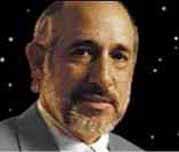 The maps (See here) that have been created by Gordon Michael Scallion show a world that has been transformed by inundations of the sea. Existing portions of the land have sunk beneath the sea, while new land masses have arisen in other places. One of the most interesting changes in the world map is that new lands have emerged out of the sea in the same places where the legendary continents of Atlantis and Lemuria were once said to have existed. The maps (See here) that have been created by Gordon Michael Scallion show a world that has been transformed by inundations of the sea. Existing portions of the land have sunk beneath the sea, while new land masses have arisen in other places. One of the most interesting changes in the world map is that new lands have emerged out of the sea in the same places where the legendary continents of Atlantis and Lemuria were once said to have existed.
In the June 1996 Issue of “The Earth Changes Report”, Scallion describes for the reader the dramatic images that appeared before him in his visions, showing the changes that would one day take place on the earth.
“..I am now shown the Earth, and as a result of the shockwave, the Earth shudders everywhere. There are winds. I am watching large landmasses that appear to be the North American Plate and the Pacific Plate. They are moving, perhaps half the plate structure of the Earth, shift as if in a single movement. They do not go up or down, but rather they slip. The movement from my perspective doesn’t seem far, but it might be something akin to twenty-five or thirty degrees of slippage.
I watch certain land masses that were warm become instantly cold. I see animals, grazing animals that look like herds of cattle, frozen in their paths. I watch other areas that are mile-high with snow, melting. I realize that it is the Antarctic. As I am watching there is a time lapse which I would assume would be weeks or months. I watch Greenland; the ice is melting so fast that water levels are rising. The water is moving in so fast that new seaways are made.
I can see inland seas in the United States. I can see a river running from the Great Lakes to Phoenix. I can see that the St. Lawrence Seaway has become a large inland sea. The Mississippi divides the United States in two. Europe has become a series of larger islands and most of Northern Europe is under water. At the same time I am seeing other land masses thrust up from the ocean bottom as a result of the shift. I see huge land masses in the Atlantic and the Pacific thrust up, even though the melting has raised the water level. Are there still twelve tectonic plates? I move round to see how many there are. After counting I find there are twenty-four..”
If the visions that GMS has so vividly described in the passages above are true premonitions of future changes to the world, then they merely add to the voices of others who have already predicted great tribulation for humanity in the days that lie ahead.
For the visions of GMS match those of St. Malachy and Sister Lúcia of Fatima, as well as the quatrains of Nostradamus and the Revelations of St. John. There is a consistency that runs through the testimony of all of these witnesses that bear out the predictions made by Jesus himself shortly before his crucifixion.
But however dramatic and terrifying these prophecies may be, they do little to prepare humanity for the times that lie ahead. For unless people are able to understand the reasons for these changes, and why these cataclysmic events are destined to occur, the prophecies themselves serve little purpose, other than to satisfy curiosity or promote sensationalism, as Pope John-Paul II warned.
This is why the predictions contained in “The Last Days of Tolemac” are so different from those mentioned above. For the Oracle of Tolemac not only describes what will happen to the earth and its peoples, often in far more dramatic terms than those used above, he goes further. He explains why these events are happening to the earth and what the future outcome will be.
But more important than all of this is the fact that he provides the key to surviving these catastrophes, and the secret to inheriting the golden future that awaits all those who pass the test of this great initiation.
Allan, Future Flooding, March 20, 2008, 1:55 pm
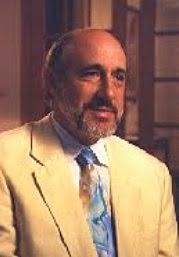 Then in August 1991 Gordon Michael Scallion (GMS) began to have nightmares. These nightmares were about the earth, which seemed to him to be a sentient being. Whereas before he had been able to look into people and see what was wrong with their physical, mental or spiritual bodies, now he seemed to be able to sense what was wrong with the earth. In these nightmares, it seemed to GMS that the earth was in great pain. Then in August 1991 Gordon Michael Scallion (GMS) began to have nightmares. These nightmares were about the earth, which seemed to him to be a sentient being. Whereas before he had been able to look into people and see what was wrong with their physical, mental or spiritual bodies, now he seemed to be able to sense what was wrong with the earth. In these nightmares, it seemed to GMS that the earth was in great pain.
He then began to get visions of various disasters that would happen to the earth. Within a month he found that these visionary experiences were beginning to come true. His first major vision was that Mexico City would have a major earthquake, leading to the death of over 5,000 people. This premonition later proved to be correct.
These visions then began to occur to GMS anywhere at any time, even while he was driving. He described the process as like watching three TV screens, one in front of him, and one on either side. Although he found that he was able to see all three screens at once, each screen had a different degree of color.
After observing these visions for some time, GMS realized that he was seeing three probable outcomes of an event. The more colorful the picture was, the more likely it was for that event to happen. The more faded the colors looked on the screen, the less likely it was for that event to occur. In this way, GMS found that he was able to interpret future events that were unfolding on the earth.
 One of Gordon Michael Scallion’s most recognized accomplishments is his “Future Map of the World”. This map is a composite summary of the many visions which he has had about the future of the earth. In his visions GMS has seen evidence of an earth that has been transformed by cataclysm, into a world that is vastly different from the earth we know today. One of Gordon Michael Scallion’s most recognized accomplishments is his “Future Map of the World”. This map is a composite summary of the many visions which he has had about the future of the earth. In his visions GMS has seen evidence of an earth that has been transformed by cataclysm, into a world that is vastly different from the earth we know today.
GMS has described how he came to draw his future map of the world, and how it would be changed as a result of the coming cataclysms.
“Since 1979 I have had ongoing visions concerning the Earth, sometimes as many as ten or more in a day, lasting from a few seconds to minutes. In 1982, I began to sketch a map based on the visions, and I updated it through the years as new information was presented to me. This map is the culmination of a major ongoing effort to consolidate all the Earth change information I have received. As a result, the “Future Map of the World” is the most comprehensive and up to date representation of Earth Change visions and information presented to me over the past seventeen years.”
Although this “Future Map of the World” has sold more than 100,000 copies, it is unfortunately no longer available on his website. However, those readers who are interested in finding out how his projected changes will affect the part of the world in which they now live, can find images at the following link.
Allan, Future Flooding, March 20, 2008, 1:52 pm
 Gordon Michael Scallion (or GMS as he prefers to be called), was a man who was leading a very happy life aboard a thirty-foot sailboat and making, in his words, “incredible sums of money”. Then, in 1979, something happened which completely changed his life. Gordon Michael Scallion (or GMS as he prefers to be called), was a man who was leading a very happy life aboard a thirty-foot sailboat and making, in his words, “incredible sums of money”. Then, in 1979, something happened which completely changed his life.
One afternoon, while he was in the middle of a conversation, he lost his voice entirely “in a split second”. He was taken to hospital where doctors conducted comprehensive tests of his vocal chords, larynx and throat muscles. Since they could find nothing wrong, they said his problems were psychosomatic.
But something very strange had definitely occurred. Within a few hours of leaving hospital, GMS found that his physical vision had changed. He now began to see colors and lights around animals, plants, trees and people. He had no idea what these colors meant and he thought that his vision was to blame.
For the next few months he consulted a variety of physicians and therapists. None could find anything wrong with his sight. Their recommendations were that he undergo either drug or shock therapy. It was a long time before GMS realized that what he was actually seeing were the “auras” of all life forms.
He decided that his best course of action was to leave Florida and hope that his vision problems would go away. He therefore returned to New England where, after a few months, he found that his vision had returned to normal. There were no more lights and colours.
Then, as unexpectedly as they had vanished, the lights and colours returned. But this time, in addition to his normal sight, he began to see moving pictures in his peripheral vision. Although many of these scenes were of people doing ordinary things, he also began to see scenes of ancient places, like Greek temples and glass domes.
Up until this time, GMS had lived a normal life. Although he was raised as a Catholic, he had no special religious or spiritual ambition in his life. As he described it: “I was just someone floating through life, very much into the material world”.
Then one day in 1985 GMS heard an inner voice which said: “We’re going to start training”. When he asked who the voice was, he was told that it was his “Monad” speaking. When he asked what this “Monad” was, he was told that it was a part of himself that he would have to discover on his own.
For the next few years this inner voice would return, usually around five o’clock in the morning. It would talk to him for about fifteen minutes, discussing such things as how the physical body or the earth worked. At the same time GMS found that he began to get visions of things that were happening in the world.
Allan, Future Flooding, March 19, 2008, 2:46 pm
Among the many questions raised by readers of “The Last Days of Tolemac”, the most provocative are those that relate to future inundations. According to the Oracle of Tolemac, when the time of “tribulation” begins, there will be cataclysmic changes to the earth. Some countries will disappear completely beneath the waves, while in other places new land masses will emerge from the ocean depths.
Many readers are skeptical about the possibility of such catastrophic earth changes in the near future. The reason they are doubtful is that the geological foundation of the earth appears to have been stable for thousands of years. Why, they ask, should things suddenly change now? The purpose of this Blog is to review these predictions and present information which may be new to many people.
There is something naturally disturbing about the idea of the earth giving way beneath our feet, and being swallowed up by the sea. According to modern scientists, because no such calamities have occurred on such a scale within the recorded history of humanity, they are unlikely to happen now.
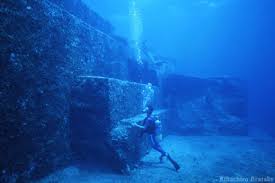 These scientists consider the Biblical description of the story of Noah and a world-wide flood to be allegorical stories that should not be mistaken for historical truth. They consider that these stories should be relegated to the category of myth, alongside such fanciful tales as the destruction of Lemuria and Atlantis. These scientists consider the Biblical description of the story of Noah and a world-wide flood to be allegorical stories that should not be mistaken for historical truth. They consider that these stories should be relegated to the category of myth, alongside such fanciful tales as the destruction of Lemuria and Atlantis.
The problem with this traditional point of view is that it presupposes that the true knowledge of the prehistory of the world is already fully known, and that no evidence exists to the contrary. But new evidence to the contrary is now being discovered by scientists in every region of the world, causing many of them to challenge their traditional view of history.
We have already presented evidence of the ruins of a sunken city located off the coast of Cuba. These ruins lie at a depth of over 2,000 feet below sea level, which is clearly too deep to be explained away by local flooding. Even if there had been a dramatic warming of the ice pack and glacial beds in distant times, this could not have raised the level of the sea by such an extent.
But these discoveries of undersea ruins are not limited to the area around Cuba. As the technology of underwater exploration has become more sophisticated so new discoveries of undersea ruins have been found in widely dispersed places around the earth.
New underwater ruins have been found off the coasts of India and Egypt, as well as near the Japanese island of Yonaguni, as shown on the link below.
http://www.grahamhancock.com/gallery/underwater/yonaguni.htm
What these discoveries suggest is that there is still much to learn about the ancient history of humanity, and that human civilization may well prove to be many thousands of years older than historians now believe.
These new discoveries of undersea ruins also raise the question that, if cities were inundated by the sea in prehistoric times, could similar events occur again in the future? The prophecies of the Oracle of Tolemac indicate that they can and will. Similar prophecies have also been made by Seers like Nostradamus, Edgar Cayce and others, as well as in various Holy Books.
There is a new witness who also believes this to be true. This man did not live many centuries ago. In fact he is alive today. He did not intend to predict future cataclysmic changes to the earth. But by an unexpected twist of fate his life was totally transformed. His name is Gordon-Michael Scallion.
Allan, Future Flooding, March 17, 2008, 10:33 pm
These sunken ruins could also provide the key to the origin of the mysterious structure of Teotihuacán in central Mexico. According to Collins:
“The Teotihuacán culture, which thrived in Central Mexico from around 400 BC through until around AD 500, remains an enigma to archaeologists. Its origin is unclear. What we do know is that legends once told by the Totonac peoples of eastern Mexico spoke of the founders of its sacred city of Teotihuacán, with its mighty Pyramids of the Sun and Moon, as having arrived on the Gulf coast from an island homeland which lay beyond the sea.”

There is an eerie similarity between the description of the ruins of the undersea city (roads, buildings and pyramids) given by Paulina Zelitsky, and the enigmatic remains of Teotihuacán that can be seen today not far from Mexico City. It suggests that there was indeed a link between the ruined civilization of Tolemac and the culture of Teotihuacan.
While it is obviously premature to draw any definite conclusions from the underwater evidence, there is every reason to believe that as further information becomes available, the accepted history of Mesoamerican cultures will have to be drastically rewritten. It will also become apparent that the history of Central America will extend back much farther in time than modern historians have thus far believed.
The origin of the legendary city of Teotihuacán is unknown. The name Teotihuacán itself is the Nahuatl (the language spoken by the Aztecs) name that was given to the place by the Aztecs, who simply referred to the builders of this city as their legendary ancestors. Modern historians attribute this site to the Toltec culture, but it is not known whether the Toltecs were an actual ethnic society, or whether the word Toltec was a generic term used by the Aztecs to describe a number of different ancient Mesoamerican societies.
What should immediately become evident is that the practice of pyramid building did not begin with the builders of Teotihuacán. For if the undersea ruins discovered off the island of Cuba do represent similar urban structures, then not only does the origin of the pyramid shape itself come into question, but also its antiquity.
Once the underwater ruins off Cuba have been extensively researched, it will be important to discover whether the “pyramid-like” structures on the sea bed are actual pyramids, and if so, whether they are of the “step-pyramid” type that is characteristic of later Mesoamerican cultures, or whether they have the smooth sides that are associated with the pyramids of Egypt on the other side of the Atlantic ocean.
If the underwater ruins off the island of Cuba do contain pyramid-like structures, this will cause historians to reconsider the possibility that the practice of pyramid building might actually have emanated from a single cultural source. In this case, as Andrew Collins has suggested above, the true origin of the pyramid shape could point to the legendary land of Atlantis, “mankind’s greatest historical enigma”.
The discovery of underwater megalithic ruins is not limited to the coast of Cuba. Many other enigmatic ruins and artifacts have been found in countries surrounding the Caribbean that add force to the argument that entire nations perished in the distant past when the ground sank beneath them and they were swallowed up by the sea, just as has been described in “The Last Days of Tolemac”.
The true origins of the cultures of Central America remain shrouded in mystery. However, as new evidence related to this subject becomes available, it will be included in later instalments. We believe that this will confirm the words of the Oracle of Tolemac, and add further credibility to the events that are predicted to occur on the earth in the immediate future.
Allan, Lost Cities of Tolemac, March 12, 2008, 10:59 pm
Following on from the previous post “Megalithic Ruins on the Sea Bed”:
When it was pointed out to Dr. Weinzweig that other underwater ruins had been discovered in neighboring areas such as the Bay of Batabanó, he replied: “We have not explored these other areas yet but we intend to in the future.” And when asked if there was any geological evidence to suggest that the islands that exist in the Caribbean today might actually be the mountain tops and high ground of a landmass that sank beneath the sea as a result of cataclysms in ancient times, he said: “Yes, geologists tell us that Yucatan, Cuba, Dominican Republic and Puerto Rico were connected at one time. There is still much to learn about the geological history of the Gulf of Mexico and the Caribbean.”
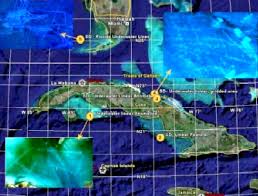 The fact that ancient underwater ruins of a hitherto unknown origin have now been found off the coast of Cuba, provide confirmation of the words of the Oracle of Tolemac, and give credence to the story of the sudden destruction of the Tolemac cities as a result of cataclysmic earth changes taking place at the time. The fact that ancient underwater ruins of a hitherto unknown origin have now been found off the coast of Cuba, provide confirmation of the words of the Oracle of Tolemac, and give credence to the story of the sudden destruction of the Tolemac cities as a result of cataclysmic earth changes taking place at the time.
This is also beginning to be accepted by mainstream science, as witnessed by a National Geographic News report dated May 28, 2002. Writing about the underwater megalithic ruins that had been discovered off the coast of Cuba, it had this to say about the ancient flood myths:
“Ancient stories of massive floods pass from generation to generation and in many places in the world are integral to a people’s spoken history. The tales differ by locale, but commonly feature either torrential rains or a hugely destructive wall of water bursting into a valley, destroying everything in its path. In many cases, the flooding is an act of retribution by displeased gods. Scientists, historians, and archaeologists view many of these enduring tales as myth, legend, or allegoric tales meant to illustrate moral principles. Recent findings indicate that at least a few of them could be based on real floods that caused destruction on an enormous scale.”
Commenting on this undersea discovery and its link with the local legends, Andrew Collins (author of the book “Gateway to Atlantis”) wrote in a Special Report:
“Myths and legends told by the indigenous peoples of the Bahaman and Caribbean archipelagos, when the Spanish first reached the New World, spoke of just such a cataclysm. They said that the waters suddenly rushed in and drowned the great landmass, breaking it up into the individual islands seen today.”
Collins went on to point out that this discovery would also have profound implications for the prehistory of the region.
“If Paulina Zelitsky and her oceanographic colleagues are right in their belief that ‘pyramids, roads and buildings’ do lie off Cuba’s western coastline, then it is clear that the prehistory of the Caribbean, and its influence on the rise of Mesoamerican civilisation, will have to be revised dramatically. Moreover, it could well be that at long last the mystery of Atlantis, mankind’s greatest historical enigma, is about to unfold in a most spectacular fashion.”
Allan, Lost Cities of Tolemac, March 12, 2008, 10:45 pm
 These megalithic structures are situated on a plateau that forms the bottom of what is thought to be a mud volcano, along a geological fault line. As Dr. Weinzweig explained, “It’s well known that ancient civilizations liked to build at the base of volcanoes, because the land is fertile. One tantalizing possibility, entirely speculative for now, is that if the legendary sunken continent of Atlantis is ever proven to have existed, these structures may have been submerged during the same cataclysm.” These megalithic structures are situated on a plateau that forms the bottom of what is thought to be a mud volcano, along a geological fault line. As Dr. Weinzweig explained, “It’s well known that ancient civilizations liked to build at the base of volcanoes, because the land is fertile. One tantalizing possibility, entirely speculative for now, is that if the legendary sunken continent of Atlantis is ever proven to have existed, these structures may have been submerged during the same cataclysm.”
Some months later, the ADC researchers, along with their Cuban partners and experts from the Cuban Academy of Sciences, returned to the underwater site with their research vessel “Ulises”. From this vessel, they sent an ROV (Remotely Operated Vehicle) down to the sea floor to film parts of the 7.7 square mile area. Because of technical problems, the ROV was only able to survey the perimeter of the site. Dr. Weinzweig pointed out that much more needed to be explored. “Based on initial explorations, we think it’s much larger than even our sonar explorations show. It may extend for kilometers.”
He went on to add the following comments:
“At this stage in the investigations, we can only speculate that some features (such as temple foundations layouts) seem to be reproduced at our site. Since the ancients built their new structures on old structural sites, we really don’t know their true antiquity. Garcilaso in “Royal Commentaries of the Incas” reports similar enormous geometrically shaped granite building stones in Cuzco (Peru) and Lake Titicaca. These megalithic granite stones are located miles from the nearest quarries. There is nothing in our understanding of ancient engineering and construction or in our present rational imagination to explain the logistics of such megalithic construction. There is much mystery here.”
The sonar images sent back by this unmanned submarine have confirmed the presence of huge, smooth, granite-like blocks in perpendicular and circular formations, as well as pyramid shapes. These stone blocks measured about 16 feet in length. While most of the blocks were exposed, others were covered in sediment and fine white sand that is characteristic of the area.
The precise age of the underwater site is unknown, although Cuban archeologists in 1966 excavated a land-based megalithic structure on the western coast, close to the underwater discovery. According to the Cuban investigators the site was thought to date from 4,000 BC. “Based on that and other geological information, we’re speculating that these are 6,000 years old. It’s not exact, but they’re very ancient”, said the Cuban researchers.
If the dating estimates indicated above prove to be accurate, they will pre-date all known human habitation in Mesoamerica. This would mean that an ancient civilization designed and erected these vast stone structures before the wheel was invented in Sumeria (3,500 BC) or the sundial in Egypt (3,000 BC).
ADC’s deep-water equipment includes a satellite-integrated ocean bottom positioning system, high precision side-scan double-frequency sonar, and the ROV. The company is also commissioning the world’s first custom designed ocean excavator for marine biology. As soon as this is operational, they plan to begin further research at the Guanahacabibes site.
When asked about their future underwater research plans, Dr. Weinzweig replied, “Presently the ship and team are conducting magnetometer, side-scan and ROV investigations of Cuban deep territorial waters in the Yucatan channel.” When he was asked if they would attempt to extract samples of the rock he answered: “To drill samples from these structures is not easy because they look like granite. And to drill granite at a depth of 600 meters is very difficult.”
Allan, Lost Cities of Tolemac, March 12, 2008, 10:38 pm
According to the Oracle, before the cities of Tolemac sank beneath the waves many thousands of years ago, they were located in the central Caribbean close to the island that we know today as Cuba. If the Oracle is correct, then the sunken ruins of these ancient cities should still exist on the ocean bed off the coast of Cuba.
Not long ago a team of Canadian and Cuban explorers, using a miniature submarine to probe the sea floor, recently discovered the ruins of what appeared to be an ancient city submerged in the deep ocean waters off the western coast of Cuba. This sunken “city” was discovered off the Guanahacabibes Peninsula on the western tip of Cuba.

In July 2000, Soviet-born Canadian ocean engineer Paulina Zelitsky of the British Columbia based Advanced Digital Communications (ADC), together with her husband Dr. Paul Weinzweig used sophisticated side-scan sonar equipment to probe the sea floor off the coast of Cuba. What they found was not only unexpected. It seemed to defy the accepted history of human culture in the region.
What the ADC researchers discovered on the sea floor were mysterious stone structures at a depth of around 2,100 feet below sea level. These megalithic structures were laid out like an underwater city, complete with roads, buildings and pyramids. When interviewed later, Paul Weinzweig said that they appeared to have been built by an unknown human civilization thousands of years ago.
“They were like what you’d find at Stonehenge or Easter Island. Some structures within the complex may be as long as 400 meters wide and as high as 40 meters”, said Dr. Weinzweig. “Some are sitting on top of each other. They show very distinct shapes and symmetrical designs of a non-natural kind. We’ve shown them to scientists in Cuba, the U.S. and elsewhere, and nobody has suggested they are natural”, he said.
Dr. Weinzweig went on to add that these stone structures bore a remarkable resemblance to the pyramids of the Mayan and Aztec temples in Mexico. Furthermore, the photos taken from the videotape show “symbols and inscriptions” in a language that has not so far been deciphered.
Commenting on this discovery Paulina Zelitsky said:
“We don’t know what it is and we don’t have the videotaped evidence of this yet, but we do not believe that nature is capable of producing planned symmetrical architecture, unless it is a miracle. … It is stunning. What we see in our high-resolution sonar images are limitless, rolling, white sand plains and, in the middle of this beautiful white sand, there are clear manmade large-size architectural designs. It looks like when you fly over an urban development in a plane and you see highways, tunnels and buildings … “
According to Paulina Zelitsky, “It’s a really wonderful structure which looks like it could have been a large urban centre. However, it would be totally irresponsible to say what it was before we have evidence.” She speculated that these structures had been built by an unknown people when the current sea floor was above the present level of the sea.
Allan, Lost Cities of Tolemac, March 12, 2008, 10:31 pm
|
The Philistines challenged Saul to decide the outcome of the battle in single combat. The Philistine champion was a fearsome warrior by the name of Goliath. Goliath was a giant of a man. He inspired such dread amongst the Israelites that no man could be found who was willing to confront him.
“Bibi” is unique among those who have been called upon to lead the nation of Israel, as he is the first and only person to become Prime Minister who was born after the foundation of Israel on May 14, 1948.
 As time passed and word of his unusual collection grew, so more and more people traveled to Ica to visit Dr. Cabrera and see for themselves these extraordinary stones. They were stored in separate rooms, based on their size and on the subject matter they depicted. Dr. Cabrera was always glad to entertain visitors and show off his display.
As time passed and word of his unusual collection grew, so more and more people traveled to Ica to visit Dr. Cabrera and see for themselves these extraordinary stones. They were stored in separate rooms, based on their size and on the subject matter they depicted. Dr. Cabrera was always glad to entertain visitors and show off his display. In the forty years that have elapsed since these stones first came to the attention of Dr. Cabrera, they have aroused fierce controversy. It would be fair to say that most archeologists and scientists trained within the accepted paradigm of history are convinced that these stones are fakes. They remain convinced that they were carved by local Indians as a means of generating income by selling them to gullible tourists as ancient artifacts.
In the forty years that have elapsed since these stones first came to the attention of Dr. Cabrera, they have aroused fierce controversy. It would be fair to say that most archeologists and scientists trained within the accepted paradigm of history are convinced that these stones are fakes. They remain convinced that they were carved by local Indians as a means of generating income by selling them to gullible tourists as ancient artifacts.






 The lure of discovering this legendary city which he called “Z” became a siren song for Fawcett, as it had done for so many adventurers before him, as well as others who were drawn to that area after his death.
The lure of discovering this legendary city which he called “Z” became a siren song for Fawcett, as it had done for so many adventurers before him, as well as others who were drawn to that area after his death.
 In his book “The Gold of the Gods” von Däniken described how Moricz had taken him to the location of these tunnels, and had led him to a vast underground chamber some 750 feet below the ground, which was clearly artificially carved out of the rock.
In his book “The Gold of the Gods” von Däniken described how Moricz had taken him to the location of these tunnels, and had led him to a vast underground chamber some 750 feet below the ground, which was clearly artificially carved out of the rock. Padre Carlos Crespi was born in Italy in 1891. He joined the Salesian Society, a Roman Catholic religious order, and was sent to minister to the people of Ecuador. Padre Crespi dedicated his life to the service and welfare of the people of Ecuador, both rich and poor alike.
Padre Carlos Crespi was born in Italy in 1891. He joined the Salesian Society, a Roman Catholic religious order, and was sent to minister to the people of Ecuador. Padre Crespi dedicated his life to the service and welfare of the people of Ecuador, both rich and poor alike. Padre Crespi invited von Däniken to examine his vast store of treasures, which he kept in various rooms. One room was devoted to carved stones. Another room contained Inca artifacts of gold, silver, copper and brass. A third room contained artifacts that were similar to the objects that von Däniken had seen in the underground cavern that he had explored with Juan Moricz.
Padre Crespi invited von Däniken to examine his vast store of treasures, which he kept in various rooms. One room was devoted to carved stones. Another room contained Inca artifacts of gold, silver, copper and brass. A third room contained artifacts that were similar to the objects that von Däniken had seen in the underground cavern that he had explored with Juan Moricz. In In the Title Deed referred to above, Juan Moricz claimed to have found “metal plaques (leaves) engraved with signs and writing”, in a large underground cavern accessed by the subterranean tunnels that he had discovered.
In In the Title Deed referred to above, Juan Moricz claimed to have found “metal plaques (leaves) engraved with signs and writing”, in a large underground cavern accessed by the subterranean tunnels that he had discovered. When Erich von Däniken published his book “The Gold of the Gods” in 1972, it quickly became an international best seller. By far the most sensational and controversial chapter in the book was his description of his visit to an underground cavern in the Andes Mountains of Ecuador, in which he claimed to have seen a vast collection of golden artifacts that were considered to be the products of some long forgotten civilization that had once existed in the area.
When Erich von Däniken published his book “The Gold of the Gods” in 1972, it quickly became an international best seller. By far the most sensational and controversial chapter in the book was his description of his visit to an underground cavern in the Andes Mountains of Ecuador, in which he claimed to have seen a vast collection of golden artifacts that were considered to be the products of some long forgotten civilization that had once existed in the area. It was in 1976 that Stan Hall, guided by the Ecuadorian explorer Juan Moricz, organized an expedition to survey the entire cave system of “Cueva de los Tayos”. This expedition was a joint British/Ecuadorian venture, and included a team of geologists and botanists as well as one hundred soldiers of the Ecuadorian army, whose task it was to provide security.
It was in 1976 that Stan Hall, guided by the Ecuadorian explorer Juan Moricz, organized an expedition to survey the entire cave system of “Cueva de los Tayos”. This expedition was a joint British/Ecuadorian venture, and included a team of geologists and botanists as well as one hundred soldiers of the Ecuadorian army, whose task it was to provide security. The rumors of artificial tunnels that existed deep beneath the ground did not begin with Juan Moricz. Soon after Francisco Pizarro and his band of conquistadores arrived in Peru in 1532, stories began to circulate about hoards of golden treasure that had been hidden by the Incas in a vast network of underground tunnels. It did not take long for these rapacious hunters of gold to search for these underground hiding places.
The rumors of artificial tunnels that existed deep beneath the ground did not begin with Juan Moricz. Soon after Francisco Pizarro and his band of conquistadores arrived in Peru in 1532, stories began to circulate about hoards of golden treasure that had been hidden by the Incas in a vast network of underground tunnels. It did not take long for these rapacious hunters of gold to search for these underground hiding places.









